new posts in all blogs
Viewing: Blog Posts Tagged with: Curriculum Corner, Most Recent at Top [Help]
Results 1 - 25 of 42
How to use this Page
You are viewing the most recent posts tagged with the words: Curriculum Corner in the JacketFlap blog reader. What is a tag? Think of a tag as a keyword or category label. Tags can both help you find posts on JacketFlap.com as well as provide an easy way for you to "remember" and classify posts for later recall. Try adding a tag yourself by clicking "Add a tag" below a post's header. Scroll down through the list of Recent Posts in the left column and click on a post title that sounds interesting. You can view all posts from a specific blog by clicking the Blog name in the right column, or you can click a 'More Posts from this Blog' link in any individual post.

By:
jilleisenberg14,
on 5/17/2014
Blog:
The Open Book
(
Login to Add to MyJacketFlap)
JacketFlap tags:
common core standards,
CCSS,
ELLs,
Curriculum Corner,
guided reading,
ELA common core standards,
Institute of Education Science,
middle school,
Reading Aloud,
elementary school,
vocabulary,
US Department of Education,
close reading,
English Language Learners,
Add a tag
 Jill Eisenberg, our Resident Literacy Expert, began her career teaching English as a Foreign Language to second through sixth graders in Yilan, Taiwan as a Fulbright Fellow. She went on to become a literacy teacher for third grade in San Jose, CA as a Teach for America corps member. She is certified in Project Glad instruction to promote English language acquisition and academic achievement. In her column she offers teaching and literacy tips for educators.
Jill Eisenberg, our Resident Literacy Expert, began her career teaching English as a Foreign Language to second through sixth graders in Yilan, Taiwan as a Fulbright Fellow. She went on to become a literacy teacher for third grade in San Jose, CA as a Teach for America corps member. She is certified in Project Glad instruction to promote English language acquisition and academic achievement. In her column she offers teaching and literacy tips for educators.
The U.S. Department of Education’s Institute of Education Science (IES) and What Works Clearinghouse (WWC) released the latest educator’s guide to present best instructional practices for English Language Learners.
Although we cannot explicitly teach all academic and content-specific words our students will need to know in their educations and careers, we can be strategic in how we teach 5-8 words a week so they can apply these word strategies to new words they come across on their own.
Last week I applied the guide’s recommendations on how to choose an appropriate text and vocabulary words for English Language Learners and I modeled it with the Lee & Low informational text, Drumbeat In Our Feet.
I will continue to focus on the guide’s first recommendation: Teach a set of academic vocabulary words intensively across several days using a variety of instructional activities.

Drumbeat In Our Feet
Using Drumbeat In Our Feet and the IES’s process, my target words are origins, vital, ethnically, diverse, unique, vibrant and varied from the “Origins of African Dance” excerpt in Drumbeat In Our Feet. See how I chose these words here.
1. Read the text
IES: Introduce the topic of the text by asking about students understanding of the topic and personal experiences. Read the excerpt aloud at the start of the lesson. (P. 24)
Lee & Low: I would read the text aloud so students who cannot comprehend the text independently can access the text whole group. All students should be able to follow along with their own student copy. Only constant interaction with the print and following along will allow students to connect with what I am saying and how I say it with what they are seeing in the print.
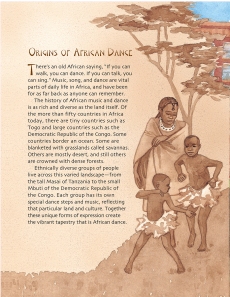
“Origins of African Dance,” excerpt from Drumbeat In Our Feet
2. Introduce the vocabulary
IES: After reading the text and stopping to ask clarifying questions, introduce the target vocabulary words and have students find the words (in their copies). Display a list of the words in the classroom. (P. 24)
3. Teach the vocabulary words in layers
IES: “Teach academic vocabulary in depth using multiple modalities (writing, speaking, listening)” and “teach word-learning strategies to help students independently figure out the meaning of words.” (P. 18-22)
Lee & Low: Over the course of 5-8 days (lesson periods), I would focus on a couple of aspects of each of the new vocabulary words. On a whole class chart where the target words are listed, I would add a new component to each word each day in order to deepen the meaning and foster familiarity with the words for students.
Together we will create a student-friendly definition; write synonyms, antonyms, examples, non-examples; determine parts of speech; draw a picture or create an action/gesture to represent the words; list related word forms and any cognates; break the word down into word parts; and use the word in a meaningful, student-generated sentence.
For example, Monday I would read the excerpt, introduce the target words, find the target words in the text, and come up with a definition for each target word. Tuesday, I would revisit the chart and add synonyms, antonyms, examples, and non-examples for all the vocabulary words to reinforce meaning. Wednesday I would cover part of speech and concrete representations, and so on.
Below is how I would teach my target word, origins, from Drumbeat In Our Feet but I would cover all of the target words each day.
Monday
- student-friendly definition: the source where something starts
Tuesday
- synonyms: beginnings, birthplace, roots, foundation
- antonyms: end, destination, result
- examples: beginning of the universe and life, family backgrounds/heritage, word roots, superhero/comic book origin stories
- non-examples: death of a star, the youngest person in the family tree, the last book in a comic book series
Wednesday
- part of speech: noun
- draw a picture to represent the word: I might draw a lake with a river leading up to a mountain and arrow pointing to where the river starts.
- create an action/gesture to represent the word: with my left hand held out at hip-level as the “lake,” I would point with my right finger to my left shoulder (the mountain) as the origin of the river. [Tip: Students are great at brainstorming concrete representations of words!]
Thursday
- list related word forms: original, originate
- list any cognates: origine (French), origen (Spanish)
Friday
- affixes: none
- use the word in a meaningful, student-generated sentence: We hiked from the lake up to the mountain looking for the origins of the river. The original owner of this house built this house all on her own in 1956.
Remember: This is a process I will repeat each week or every 5-8 lessons with a new text and set of target words. While my students may know only up to 400 new vocabulary words by the end of the year, this repeated process will allow them to tackle new vocabulary words in other content classes and in independent reading.
Next week, we will take a look at how to incorporate the selected vocabulary into activities that support listening, speaking, and writing practice for English Language Learners.
Further reading on supporting English Language Learners in the classroom:
Filed under:
Curriculum Corner Tagged:
CCSS,
close reading,
common core standards,
ELA common core standards,
elementary school,
ELLs,
English Language Learners,
guided reading,
Institute of Education Science,
middle school,
Reading Aloud,
US Department of Education,
vocabulary 


By:
jilleisenberg14,
on 5/10/2014
Blog:
The Open Book
(
Login to Add to MyJacketFlap)
JacketFlap tags:
middle school,
elementary school,
vocabulary,
ell,
reading comprehension,
close reading,
English Language Learners,
common core standards,
CCSS,
Curriculum Corner,
ELA common core standards,
informational nonfiction,
Add a tag
 Jill Eisenberg, our Resident Literacy Expert, began her career teaching English as a Foreign Language to second through sixth graders in Yilan, Taiwan as a Fulbright Fellow. She went on to become a literacy teacher for third grade in San Jose, CA as a Teach for America corps member. She is certified in Project Glad instruction to promote English language acquisition and academic achievement. In her column she offers teaching and literacy tips for educators.
Jill Eisenberg, our Resident Literacy Expert, began her career teaching English as a Foreign Language to second through sixth graders in Yilan, Taiwan as a Fulbright Fellow. She went on to become a literacy teacher for third grade in San Jose, CA as a Teach for America corps member. She is certified in Project Glad instruction to promote English language acquisition and academic achievement. In her column she offers teaching and literacy tips for educators.
As I mentioned last week, the U.S. Department of Education’s Institute of Education Science (IES) and What Works Clearinghouse (WWC) released the latest educator’s guide to present best instructional practices for English Language Learners.
Let’s take a look at the guide’s first recommendation: Teach a set of academic vocabulary words intensively across several days using a variety of instructional activities.
Here is an example of how to apply the first recommendation using IES’s process and Lee & Low Books’ informational nonfiction text, Drumbeat In Our Feet.

Drumbeat In Our Feet
- Choose a text:
IES: “Choose a text that is brief, interesting, and engaging for the students; contains a variety of target academic words to focus on; connects to a given unit of study and builds the students’ knowledge of a topic; provides sufficient detail and examples for students to be able to comprehend the passage; and contains ideas that can be discussed from a variety of perspectives.” (P. 14)
Lee & Low: Based on these criteria, I selected the first chapter, “Origins of African Dance.” The reading level of Drumbeat In Our Feet is best suited for fourth through sixth graders. The topic of dance history is relatable and relevant to this age group. It will spark student interest and engagement and promote discussion. The short excerpt is an appropriate length that can be read within one class period and is worth multiple re-readings over the coming days.
- Select vocabulary:
IES: Select a small number of academic vocabulary words (content-specific and general academic) for multi-day instruction. For in-depth exploration, consider only 5-8 words. The IES suggests choosing words “central to understanding the text, frequently used in the text, might appear in other content areas, with multiple meanings, with affixes, or cross-language potential.” (P. 16-17)
Lee & Low: Based on these criteria, I picked: origins, vital, ethnically, diverse, unique, vibrant and varied from the “Origins of African Dance” excerpt in Drumbeat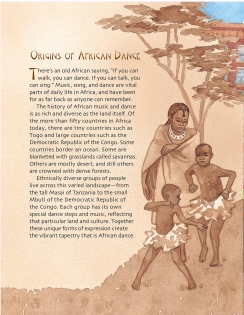 In Our Feet. These words are key to understanding the text, will appear in other content areas students will explore, and several have multiple meanings.
In Our Feet. These words are key to understanding the text, will appear in other content areas students will explore, and several have multiple meanings.
Additionally, I used Flocabulary’s Wordlists to check my words against their grade level recommendations because Flocabulary’s researchers analyze grade level materials and high stakes tests to determine what academic words students should know in each grade. Origins is on the third grade word list and variety (related word form to varied) is on the fourth grade word list. Vital, diversity (related word form to diverse), unique, and vibrant are on the sixth grade word list. However, there are quite a few wordlists available to do this verification so utilize what your district/school recommends or another you have confidence using.
Next week, we will take a look at how to introduce and teach the selected vocabulary across multiple lesson periods using Drumbeat In Our Feet followed by writing and speaking/listening activities for your students to grasp the words’ meanings.
Further reading on supporting English Language Learners in the classroom:
Filed under:
Curriculum Corner Tagged:
CCSS,
close reading,
common core standards,
ELA common core standards,
elementary school,
ell,
English Language Learners,
informational nonfiction,
middle school,
reading comprehension,
vocabulary 


By:
jilleisenberg14,
on 5/3/2014
Blog:
The Open Book
(
Login to Add to MyJacketFlap)
JacketFlap tags:
middle school,
elementary school,
ell,
Educators,
reading comprehension,
common core standards,
CCSS,
Curriculum Corner,
ELA common core standards,
Add a tag
 Jill Eisenberg, our Resident Literacy Expert, began her career teaching English as a Foreign Language to second through sixth graders in Yilan, Taiwan as a Fulbright Fellow. She went on to become a literacy teacher for third grade in San Jose, CA as a Teach for America corps member. She is certified in Project Glad instruction to promote English language acquisition and academic achievement. In her column she offers teaching and literacy tips for educators.
Jill Eisenberg, our Resident Literacy Expert, began her career teaching English as a Foreign Language to second through sixth graders in Yilan, Taiwan as a Fulbright Fellow. She went on to become a literacy teacher for third grade in San Jose, CA as a Teach for America corps member. She is certified in Project Glad instruction to promote English language acquisition and academic achievement. In her column she offers teaching and literacy tips for educators.
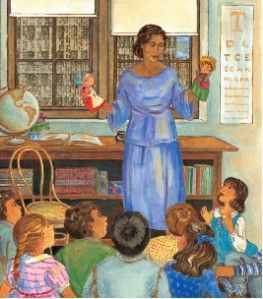
from The Storyteller’s Candle by Lucia Gonzalez
Many of our classrooms include students whose home language is not English. In fact, EngageNY released a report documenting that in 2012-2013 New York State alone taught students who spoke more than 140 languages at home with Spanish making up nearly 65% of all English Language Learners.
Teaching students who are English Language Learners is enormously rewarding and meaningful. However, it at times can feel overwhelming, especially for those who have ever juggled multiple languages at once in the same classroom, supported a student whose language few of their peers or staff spoke, or worked with a student who had little formal school experience beforehand.
The Institute of Education Sciences (IES) released a new practice guide for teaching academic content and literacy to English Learners in elementary and middle school. In this report, IES presents four recommendations to teach and develop English language skills in grades K-8.
Prestwick Café describes why it is critical to give students tools they can apply on their own, like Greek and Latin roots, and points out that even if we teach 10 new words a week all school year long, that is merely 400 vocabulary words—not nearly enough for a student’s journey to become “career and college ready” by high school graduation. While we can not teach every vocabulary word that our students will need or might come across in their reading, we can give them the strategies to build their vocabulary with and without us.
Over the next few weeks, we will focus on the practice guide’s first recommendation—choosing and teaching a set of academic vocabulary words over the course of several days in a variety of instructional activities and what it looks like in action with our books. Using the IES practice guide, we will demonstrate how to choose a text for English Language Learners and significant vocabulary words, to teach selected words, and to incorporate listening, speaking, writing, and reading practice for ELLs in vocabulary instruction.

Quinito, Day and Night / Quinito, día y noche
Additional information, activities and advice for educators and Spanish-speaking families of English Language Learners (ELLs) can be found at ¡Colorín Colorado!
Further reading on supporting English Language Learners in the classroom from The Open Book blog:
Using Dual Language And Bilingual Books And Parent-Volunteers To Foster Deep Thinking
Using Dual Language And Bilingual Books In First And Second Grade
Using Dual Language And Bilingual Books In Third And Fourth Grade
Filed under:
Curriculum Corner Tagged:
CCSS,
common core standards,
Educators,
ELA common core standards,
elementary school,
ell,
middle school,
reading comprehension 


By:
Hannah,
on 4/22/2014
Blog:
The Open Book
(
Login to Add to MyJacketFlap)
JacketFlap tags:
common core,
Curriculum Corner,
informational text,
Holidays,
photos,
nonfiction,
environment,
Earth Day,
environmentalism,
Add a tag
In an era of great global change, it’s more important than ever to take a moment today to think about how the Earth sustains us and how we can help to sustain it in return.
We asked author Jan Reynolds, whose work we have been showcasing throughout April here on the blog and whose travels have taken her from a hot air balloon over Mount Everest to the Sahara Desert, to share a few of her favorite photos and some thoughts on celebrating Earth Day:
I chose photos for Earth Day that aren’t big landscapes on purpose. We think of Earth Day as the Earth, pristine, something separate, while in reality…
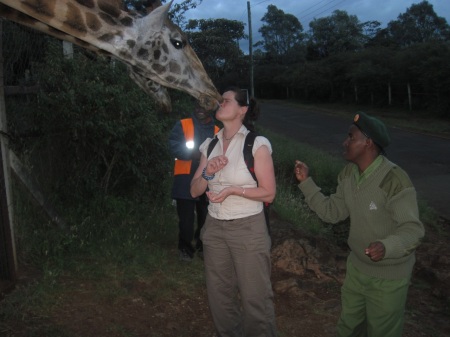 …the Earth is one big party with all kids of life on it, not just plant life and oceans.
…the Earth is one big party with all kids of life on it, not just plant life and oceans.
 We are all a part of it, including man.
We are all a part of it, including man.
 So therefore, the baboon pics. Hoping we can see ourselves in the baboons, and vice versa.
So therefore, the baboon pics. Hoping we can see ourselves in the baboons, and vice versa.
Further Reading and Resources:
Don’t miss our Pinterest board of recommended books about Earth, the Environment, and Human Impact:
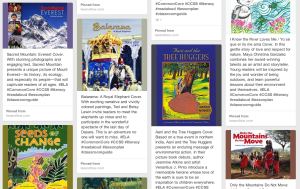
Raising Global Citizens: Jan Reynolds Author Study
Teaching Geo-Literacy Using the Vanishing Cultures series
Where in the World? Using Google Maps to explore the Vanishing Cultures series
Filed under: Curriculum Corner, Holidays Tagged: common core, Earth Day, environment, environmentalism, informational text, nonfiction, photos 


By:
jilleisenberg14,
on 4/19/2014
Blog:
The Open Book
(
Login to Add to MyJacketFlap)
JacketFlap tags:
History,
poetry,
slavery,
Educators,
National Poetry Month,
reading comprehension,
close reading,
African/African American Interest,
common core standards,
CCSS,
Curriculum Corner,
appendix b,
ELA common core standards,
Add a tag
 Jill Eisenberg, our Resident Literacy Expert, began her career teaching English as a Foreign Language to second through sixth graders in Yilan, Taiwan as a Fulbright Fellow. She went on to become a literacy teacher for third grade in San Jose, CA as a Teach for America corps member. She is certified in Project Glad instruction to promote English language acquisition and academic achievement. In her column she offers teaching and literacy tips for educators.
Jill Eisenberg, our Resident Literacy Expert, began her career teaching English as a Foreign Language to second through sixth graders in Yilan, Taiwan as a Fulbright Fellow. She went on to become a literacy teacher for third grade in San Jose, CA as a Teach for America corps member. She is certified in Project Glad instruction to promote English language acquisition and academic achievement. In her column she offers teaching and literacy tips for educators.
1. Teaching Students About Narrator Bias
Etched In Clay is a compelling case study for narrator bias and trustworthiness. The text structure with 13 narrators and its economy of words make Dave’s story captivating, especially to middle grade  students who are beginning to engage with primary sources from the period of American slavery. Students can analyze how each speaker’s social experiences, status, motivations, and values influence his/her point of view, such as evaluating the poems of the slave-owners who would have had a vested interest in popularizing a particular narrative of slavery.
students who are beginning to engage with primary sources from the period of American slavery. Students can analyze how each speaker’s social experiences, status, motivations, and values influence his/her point of view, such as evaluating the poems of the slave-owners who would have had a vested interest in popularizing a particular narrative of slavery.
Using multiple perspectives to tell the story of one life is a striking display of how events can be interpreted and portrayed by different positions in the community. Students face the task of examining the meaning and nuance of each narrator (13 in total!) and what they choose to convey (or don’t).
Discussion questions include:
- Why might the author choose to share Dave’s story using multiple speakers? How do multiple narrations develop or affirm the central idea?
- How do the author’s choices of telling a historical story in present tense and first person narration affect our sympathy toward the narrators and events in the book?
- Select a poem, such as “Nat Turner,” and defend why the author chose a particular narrator to tell that event or moment. How would the event and poem be different if another, like Reuben Drake, had told it?
- Are there narrators the readers can trust more than others? Why or why not? What makes a narrator (un)trustworthy? How is each narrator (un)reliable? Why might one of these narrators not tell readers the “whole” truth? Does having more than one narrator make the story overall more reliable? Why or why not?
- How does a narrator’s position in society or in Dave’s life affect what he/she knows? How does the historical context affect what a narrator may or may not know and his/her reliability? How can readers check a narrator’s knowledge of facts?
- What is the motivation of each narrator to share?
- Does this alternation between narrators build compassion or detachment for Dave in readers? How so?
- Why is it important to learn the history of slavery from slaves themselves?
- Compare and contrast the conditions of slavery from Dave’s point of view and Lewis Miles.
- How do the slaveholders depict the relationships with their slaves? How do the slaves depict their relationships with the slaveholders?
- Compare Dave and Lewis Miles’ perceptions of the Civil War.
- Consider whether Dave and David Drake should be considered one perspective or two.
- Contrast how each narrator feels about antebellum South Carolina.
- Who might be the audience the narrators are telling their version of events to (themselves, God, a news reporter, etc.)? Are they the same? Why is intended audience important to consider?
- Argue whether 13 points of view flesh out this figure or make Dave and his life even more elusive.
2. Poetry Month and Primary Sources
As “Primary Sources + Found Poetry = Celebrate Poetry Month” suggests, the Library of Congress proposes an innovative way to combine poetry and nonfiction. Teaching With The Library of Congress recently re-posted the Found Poetry Primary Source Set that “supports students in honing their reading and historical comprehension skills by creating poetry based upon informational text and images.” Students will study primary source documents, pull words and phrases that show the central idea, and then use those pieces to create their own poems.
This project not only enables teachers to identify whether a student grasps a central idea of a text, but also encourages students to interact with primary sources in much the same way as Etched In Clay’s Andrea Cheng. When researching Dave’s life and drawing inspiration for her verses, Andrea Cheng integrated the small pieces of evidence of Dave’s life, including poems on his pots and the bills of sale.
3. Common Core and the Appendix B Document
Many middle school educators are currently using Henrietta Buckmaster’s “Underground Railroad,” a recommended text exemplar for grades 4-5, and Ann Petry’s Harriet Tubman: Conductor on the Underground Railroad and Frederick Douglass’s Narrative of the Life of Frederick Douglass An American Slave, Written by Himself, recommended text exemplars for grades 6-8 in the Common Core State Standards’ Appendix B document.
Educators can couple Etched In Clay with those texts to involve reluctant or struggling readers, prepare incoming middle school students, and scaffold content and language for English Language Learners. Additionally, Andrea Cheng’s biography offers educators an inquiry-based project for ready and advanced readers to analyze “how two texts address similar themes or topics in order to build knowledge or to compare the approaches the authors take” (CCSS.ELA-LITERACY.CCRA.R.9).
For a more inclusive, diversity-themed collection of contemporary authors and characters of color, check out our Appendix B Diversity Supplement.
Further reading:
Andrea Cheng on Writing Biography in Verse
A Poem from Etched in Clay
Filed under:
Curriculum Corner Tagged:
African/African American Interest,
appendix b,
CCSS,
close reading,
common core standards,
Educators,
ELA common core standards,
History,
National Poetry Month,
poetry,
reading comprehension,
slavery 


By:
jilleisenberg14,
on 4/15/2014
Blog:
The Open Book
(
Login to Add to MyJacketFlap)
JacketFlap tags:
children's books,
diversity,
geography,
Educators,
environmentalism,
classroom projects,
reading comprehension,
close reading,
digital literacy,
visual literacy,
common core standards,
CCSS,
Curriculum Corner,
ELA common core standards,
geoliteracy,
Add a tag
Throughout April, we are exploring how Jan Reynolds’ Vanishing Cultures series can be used in the classroom to teach about the environment, geo-literacy, global citizenship, and nonfiction. Today, we want to share how one school has integrated geo-literacy with digital and visual literacy.
Michael Willis and the Kaleidoscope Team at Williston Central School in Williston, Vermont helped their 3rd and 4th grade classroom build a map on Google Maps of the cultures featured in the books. Through this project, students were able to investigate topics and themes in the Vanishing Cultures series, practice deriving information from other formats and develop visual literacy skills, and gain rich social studies/ geography content knowledge.
The Google Maps assignment is an exciting way to engage reluctant or struggling readers, facilitate the participation of visual learners and English Language Learners, or provide an extension opportunity for ready or advanced learners. The 3rd and 4th grade students hope that in addition to deepening their own knowledge about traditional cultures, their project provides useful and valuable information for others.
From educator, Michael Willis: My 3rd and 4th grade team wanted to get an author in to share their experiences with our young writers. Ideally we wanted a local person and sure enough Jan Reynolds, who lives in Vermont, was available. First we hit up our library as well as the others in our area and got our hands on Jan’s Vanishing Cultures series. We read aloud her books, visited her website, and then Jan came.
She shared a movie about her work and travels with our whole team in the auditorium and then spent time answering questions in smaller groups. It was during one of the small presentations that Jan mentioned how great it would be to use Google Maps to highlight her book locations. I thought it would be a great project for our students, and they were motivated to do it by the idea that the project could be shared with other students who read Jan’s books.
We used Google Maps to plot out where in the world Jan’s Vanishing Cultures books take place, and put together this map.

Williston Central School Google Earth Map for Vanishing Cultures series
Here’s what the students had to say about the project:
What was it like doing the Google Earth Project?
Grace – I thought that it was really fun because we were working with a famous author. We had to get all of her books and look up where she had been using Google Earth.
Isabelle – We dropped pins on the locations using the facts and map information on the inside covers of her books. Doing this project motivated us to have to read her books and learn about the cultures that she visited. It made me appreciate how lucky we are to have the things we have.
Logan – The map project was really interesting. It helped me understand how many different places Jan had been. I didn’t know that there were cultures vanishing from the Earth. It made me want to learn more about the cultures. The books were helpful because she had really been to visit the people, talk to them, and learn how they live.
Addie – We used the summaries and the content from the books to add a brief description to the pins which marked the places. This project motivated us because we wanted to help others learn. It felt special because we were the first ones to do this and actually get published! Plus, I didn’t even know these cultures existed!
Myleigh – The motivating part of the project was that I don’t usually get to explore the world. How often do people get to learn about this kind of thing? It was almost like traveling the world reading Jan’s books.
What do you think is the purpose of Jan’s books? What do they help you realize?
Sean – Her purpose was to teach children about the Vanishing Cultures and what is happening to them. I think Jan’s message was not that they need our help because they have been surviving for a long time. She was telling us that we should respect them, their way of life, and to respect their land. I learned that they are just like everyday people. To them, I bet we would look like the outsiders. Everyone has traditions that they do.
Addie – We are lucky to have so many resources to use.
Grace – It made me realize how different these cultures are from us
Isabelle – It also made me realize that we all are not that different. We may have different stuff and live in different parts of the world, but we all are people.
Grace – We can help other cultures by protecting the regions where they live
Addie – We realized that while our cultures are different, we shouldn’t force them to disappear because we all have something to learn from each other. We could be more conscious of our waste and our pollution and that could help them keep their culture and survive
Isabelle – I think that it is important to respect different cultures because it’s how they live. The Celebrations book helped me learn that different cultures celebrate different holidays
What was it like having Jan visit?
Myleigh – It was really cool to see Jan’s presentation and to hear her describe her trips first hand. It really helped me put myself in her shoes and understand what she was going through. When I was hearing her use such descriptive language it felt like I was right there with her.
Katrina – I think that since she came it really helped us understand that you should appreciate what you have – even though the people in the other cultures don’t have a lot they still seemed happy. The people in those cultures work hard to live off the land and work with nature by using their resources. It really helped me learn about cultures that I didn’t know about.
For more resources on the Vanishing Cultures series, check out:
How are you using the Vanishing Cultures series in your classroom? Share your thoughts, experiences, and strategies that have worked in your school and community! Post a comment below or email Lee & Low at [email protected].
Filed under:
Curriculum Corner Tagged:
CCSS,
children's books,
classroom projects,
close reading,
common core standards,
digital literacy,
diversity,
Educators,
ELA common core standards,
environmentalism,
geography,
geoliteracy,
reading comprehension,
visual literacy 


By:
Hannah,
on 4/12/2014
Blog:
The Open Book
(
Login to Add to MyJacketFlap)
JacketFlap tags:
Latino/Hispanic/Mexican,
Día de los niños/Día de los libros,
Curriculum Corner,
English-Spanish,
libros en Español,
Reading Aloud,
parents,
bilingual books,
Read Aloud,
guest blogger,
ell,
bilingual,
teaching resources,
bilingual education,
reading comprehension,
Add a tag

Jennifer Brunk has been teaching Spanish and English learners from preschool to university level for over 20 years. She re sides in Wisconsin where she raised her three children speaking Spanish and English. Jennifer blogs about resources for teaching Spanish to children on Spanish Playground. The following post is reprinted with permission from her original post at Spanish Playground.
sides in Wisconsin where she raised her three children speaking Spanish and English. Jennifer blogs about resources for teaching Spanish to children on Spanish Playground. The following post is reprinted with permission from her original post at Spanish Playground.
Research has shown that reading to children helps them learn vocabulary and improves listening comprehension skills. As a parent or teacher, you are probably convinced of the value of reading to your child in Spanish, but how should you do it to promote language development?
First, it is important to keep in mind that above all reading should be enjoyable. We want to create positive associations with reading in any language. So, use these strategies and add plenty of silliness, snuggling, or whatever makes your child smile.
1. Identify core vocabulary in the story. If there are words that are central to the story that your child does not know, teach them first or make them clear as you read by pointing to the illustrations or using objects.
2. Use illustrations, objects, gestures and facial expressions to help kids understand new words. Choose stories with a limited number of new vocabulary words and a close text-to-picture correspondence.
3. Simplify the story if necessary. It is fine to reword or skip words or sentences. As your child becomes familiar with the story and acquires more vocabulary, you can include new language.
4. Read slowly. Children need time to process the sounds, connect them with the illustrations and form their own mental images.
5. Pronounce words as correctly as possible. To develop listening comprehension skills and learn new vocabulary, children need to hear correct pronunciation and natural rhythm. If your Spanish pronunciation is a work in progress, take advantage of technology. Look for books with audio CDs and ask a native speaker to record stories. At first, listen to the story with your child and take over reading when you are confident of the pronunciation.
6. Engage your child with the story by providing different ways for her to participate.Ask questions that can be answered by pointing or say a repeated phrase together. You can also give your child a toy or object that she can hold up each time she hears a key word.
7. Read the same story over and over. Repetition is essential to language learning.
8. Relate the story to your child’s life by drawing parallels as you read: Tiene un perro. Nosotros también tenemos un perro. As you go about your daily routines, refer to stories you have read.
9. Use puppets or figures to act out stories when you are playing with your child. Dramatizing the story adds movement to enhance learning and provides essential repetition of the language in context.
10. Do activities that expand on the language in the book. Look for songs, crafts or games with related vocabulary and structures.
 Visit Spanish Playground for more great resources for teaching Spanish to children, and don’t forget that Dia de los niños/ Día de los libros is in just a few weeks! What are you doing to celebrate? What are your favorite books in Spanish to read aloud?
Visit Spanish Playground for more great resources for teaching Spanish to children, and don’t forget that Dia de los niños/ Día de los libros is in just a few weeks! What are you doing to celebrate? What are your favorite books in Spanish to read aloud?
Filed under:
Curriculum Corner,
guest blogger Tagged:
bilingual,
bilingual books,
bilingual education,
Día de los niños/Día de los libros,
ell,
English-Spanish,
Latino/Hispanic/Mexican,
libros en Español,
parents,
Read Aloud,
Reading Aloud,
reading comprehension,
teaching resources 


Andrea Cheng is the author of several critically-acclaimed books for young readers. Her most  recent novel, Etched in Clay, tells the story in verse of Dave the Potter, an enslaved man, poet, and master craftsperson whose jars (many of which are inscribed with his poetry and writings) are among the most sought-after pieces of Edgefield pottery. Etched in Clay recently won the Lee Bennett Hopkins Poetry Award.
recent novel, Etched in Clay, tells the story in verse of Dave the Potter, an enslaved man, poet, and master craftsperson whose jars (many of which are inscribed with his poetry and writings) are among the most sought-after pieces of Edgefield pottery. Etched in Clay recently won the Lee Bennett Hopkins Poetry Award.
When I heard an NPR review of Leonard Todd’s book, Carolina Clay, I knew that Dave’s was a story I wanted to  tell. And from the start, I knew that I wanted to tell it in verse. Readers often ask me why. I didn’t make this decision consciously, but subconsciously, I think there were reasons.
tell. And from the start, I knew that I wanted to tell it in verse. Readers often ask me why. I didn’t make this decision consciously, but subconsciously, I think there were reasons.
The evidence of Dave’s life is fragmentary: pots and shards and bills of sale. This means that each small piece of evidence stands for something more, something much larger than the object itself. For example, the first bill of sale shows that Harvey Drake purchased a teenage boy for six hundred dollars. He was “country born” with “good teeth” and “a straight back. “ (Etched in Clay, p. 7) There is so much sorrow in these few words. A person is being evaluated and then sold like an animal. After a quick transaction, he becomes the property of someone else. The only way I know to allow a reader to feel this sorrow is through the intensity of a poem.
And of course, Dave was a poet, so it seems fitting to tell his life in verse. Sometimes he had fun with words and puns and tongue twisters like mag-nan-i-mous and se-ver-it-y. Other times he expressed the sorrow of his life in cryptic couplets:
I wonder where is all my relation
friendship to all—and every nation.
Poetry is intense and versatile. Each word and each phrase is loaded and can hold multiple meanings. This is the way that Dave wrote, and it is the only way that I could attempt to represent his life.
The other question people often ask is why I chose to tell the story in multiple voices.
The first poems I wrote were from Dave’s point of view. I started with:
Another Name
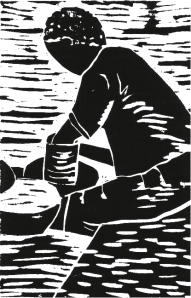
Illustration from Etched in Clay
Dave, 1815
Master says ”Dave—
That suits you.
That’s your name.”
He can call me
Whatever he pleases,
Tom or John or Will or Dave,
No matter.
I had another name once.
I can’t remember the sound of it;
But I know the voice,
smooth and soft,
that whispered it
close to my ear
in the still night.
And then
my mother was gone.
After writing several poems in Dave’s voice, I wanted to explore the other people in Dave’s life. What did they say? How did they feel? How did they relate to Dave? What about Harvey Drake, a young man sent by his uncle to purchase a slave? Was he confident in making this purchase? Did he have doubts? What about Eliza, a house slave thought to be Dave’s first wife? I cannot imagine the sorrow of their separation when she was sold and taken to Alabama. I wanted to hear from Dave’s subsequent owners: Abner Landrum, John Landrum, Reuben Drake, Lewis Miles, and BF Landrum. Lewis Miles and Dave seemed to have become friends of sorts, even joking about the way to place a handle on a clay pot. And then there was the despicable Benjamin Franklin Landrum who says “It takes a strong whip/to control these slaves.” (EIC p. 101.) After a terrible beating, Dave finds one of the slaves “…hanging limp/and her pulse is gone.”

Illustration from Etched in Clay
Multiple voices can allow the readers a glimpse into the minds of various characters. Why do they do what they do? How do they rationalize their actions to themselves and others? How do they relate to other characters? With multiple voices, the writer can create a world.
While doing the research for Etched in Clay, I read articles about Dave’s pottery and viewed photographs of his jugs. I read about the history of South Carolina and the Landrum Family that owned Dave through much of his life. I read hundreds of slave narratives. And then I drove 11 hours from Ohio to South Carolina.
While traipsing across the Carolina fields where Dave once lived and worked, it started drizzling. After a short storm, the sun came out, and I saw that the field was littered with shards of pottery, glistening in the morning light. I picked up a few shards and wondered if perhaps they were Dave’s. Then I walked downhill to the creek where Dave and others dug the clay. The water was cold and running fast. The banks were steep. I held a handful of wet clay in my hand. In the evening, at the Edgefield Inn, near Dave’s home, I wrote many of the poems in Etched in Clay. Like the shards I had seen, I hope that they create a whole.
Further Reading:
An interview with Andrea Cheng about Etched in Clay in School Library Journal
A look at how Andrea Cheng made the woodcut illustrations for Etched in Clay
Filed under:
Curriculum Corner Tagged:
Etched in Clay,
National Poetry Month,
Nonfiction poetry,
poetry,
teaching resources,
writing,
writing resources 


By:
jilleisenberg14,
on 4/8/2014
Blog:
The Open Book
(
Login to Add to MyJacketFlap)
JacketFlap tags:
children's books,
diversity,
Reading Aloud,
geography,
Educators,
environmentalism,
reading comprehension,
close reading,
Multiracial,
common core standards,
CCSS,
Curriculum Corner,
guided reading,
ELA common core standards,
geoliteracy,
vanishing cultures,
Add a tag
Jill Eisenberg, our Resident Literacy Expert, began her career teaching English as a Foreign Language to second through sixth graders in Yilan, Taiwan as a Fulbright Fellow. She went on to become a literacy teacher for third grade in San Jose, CA as a Teach for America corps member. She is certified in Project Glad instruction to promote English language acquisition and academic achievement. In her column she offers teaching and literacy tips for educators.
Eisenberg, our Resident Literacy Expert, began her career teaching English as a Foreign Language to second through sixth graders in Yilan, Taiwan as a Fulbright Fellow. She went on to become a literacy teacher for third grade in San Jose, CA as a Teach for America corps member. She is certified in Project Glad instruction to promote English language acquisition and academic achievement. In her column she offers teaching and literacy tips for educators.

Vanishing Cultures: Mongolia
Last week on the blog we spotlighted the work of Jan Reynolds, an author and explorer who has written nonfiction for young readers about cultures across the globe. If we had read the Vanishing Cultures series when I was a classroom teacher, my students would have been competing with each other over who knew the most outrageous fact. Did you know the Tiwi, an aboriginal tribe from an island off the coast of Australia, eat mangrove worms fresh? Did you know the Inuit from the Hudson Bay build rock piles that are stacked to look like men in order to scare caribou toward the real Inuit hunters?
My students loved to play the “did you know…” game. That became a popular sentence starter in our classroom. Students would scramble for the latest book or periodical on animals, prehistoric times, and exotic locales. The peregrine falcon, megalodon, and the giant panda were unshakable favorites.
Yet, we don’t want students to know “just facts” as if they are mini-encyclopedias. We aspire for our students to wonder and to investigate how our world works, how we are all connected to our environment and other humans halfway around the globe, and how our actions here affect others way over there.
The Common Core brings a refreshed spotlight to the nonfiction genre in children’s books, challenging publishers, educators, librarians, and parents to present children with high interest, high quality texts. What a time to engage students’ senses, sustain their wonder, and teach them geo-literacy!
National Geographic affirms, “with the rapid pace of change in the 21st century, it is more important than ever that young people understand the world around them.” It has adopted the concept of “geo-literacy,” and even gone so far as to create a community to support and cultivate “geo-educators.”

Vanishing Cultures: Himalaya
Enjoyed in classrooms around the nation, Jan Reynolds’ collection on at-risk traditional cultures is even more significant and striking today than when the series was first published. The persistent popularity of the Vanishing Cultures series speaks to its captivating power to make geo-literacy learning personal and tangible. This collection supports geo-literacy learning because each book challenges students to examine:
- the characteristics of each culture
- what makes this featured culture unique
- how this group of people has adapted to survive in its environment
- what challenges this group of people faces
- the modern human impact (positive and negative) on this traditional culture and the environment
- why the author would want to share this story with children and create a whole series on this topic
When we educate children about other cultures and geo-literacy more broadly, we are implanting the idea that we learn in order to make better, more informed decisions. Before our students become adults in positions of power, we want them to have practice in pausing and thinking how their choices to construct their community could disturb the environment of another community or animal species.
The Vanishing Cultures books encourage students to reason and reflect critically and deeply about how humans affect other humans and why we all benefit from diversity. As classrooms around the country can attest, Jan Reynolds’ books will not only spark enthusiasm that we hope ignites into lifelong careers and hobbies, but also conversation on what information we need to make decisions that will shape our and others’ health, environment, and well-being.

Vanishing Cultures: Down Under
Classroom Ideas for Comparing and Contrasting Between Vanishing Cultures Books and Teaching Geo-Literacy
(Reading Standards, Integration of Knowledge & Ideas, Strand 9)
(Writing Standards, Research to Build & Present Knowledge, Strand 7 and 9)
- How are these cultures similar and different from each other? What actions do these families take in both books to protect their ways of life?
- Compare how the challenges of each culture are similar or different.
- Compare how the children in each book demonstrate their pride in their culture. Why is it important for the children to feel proud of who they are and their way of life?
- What is the author’s purpose in starting each book with the parents telling their child a story from long ago? How does this affect the tone of and set the mood in the series? How does this opening support the central idea?
- After reading two or more of the Vanishing Cultures books, what common features or characteristics does a Vanishing Culture book have? If you were to write a book about your family’s culture, what kinds of things happen in a Vanishing Cultures book? What are some things that will not happen in a Vanishing Cultures book? What central ideas and lessons will be in the book?
- Have students create a chart to compare different aspects of life across two or more cultures. Write the name of each cultural group being compared on the top of the chart, and list the topics for points of comparison down the left side. Here are some possible topics: Food, Clothing, Climate, Geography, Important Animals, Homes, How Children Help (Chores), Roles of Men & Women, Family Life, How People Have Fun, Beliefs, Means of Transportation, Challenges Faced Today, Celebrations, Honoring Loved Ones. Have students record appropriate information as they read and re-read the texts.
- One elementary class created the “Around the World with Jan Reynolds” project on Google Earth. Explore where each of the books takes place. Compare the political map with the satellite map. Reflect on how geography has helped or hurt the survival of these ancient cultures. Students can create their own maps of the different cultures at National Geographic’s MapMaker’s 1-Page Maps.
Filed under:
Curriculum Corner Tagged:
CCSS,
children's books,
close reading,
common core standards,
diversity,
Educators,
ELA common core standards,
environmentalism,
geography,
geoliteracy,
guided reading,
Multiracial,
Reading Aloud,
reading comprehension,
vanishing cultures 


By:
Hannah,
on 4/1/2014
Blog:
The Open Book
(
Login to Add to MyJacketFlap)
JacketFlap tags:
nonfiction,
environmentalism,
teaching resources,
global citizenship,
Jan Reynolds,
CCSS,
diversity in the classroom,
Curriculum Corner,
informational text,
geoliteracy,
Add a tag
Today’s world is smaller than ever, and as technology continues to advance it will only get smaller. Raising students for success means teaching them how to be global citizens, emphasizing cultural literacy and geoliteracy, and exposing them to people whose lives differ from theirs.

For this, there’s no better author than Jan Reynolds. Reynolds is a writer, photographer, and adventurer who has written over fourteen nonfiction books for children about her travels. Her work has appeared in numerous publications including National Geographic, The New York Times, and Outside Magazine. Reynolds is an avid skier, mountain climber, and adventurer who holds the record for women’s high altitude skiing, was part of the first expedition to circumnavigate Mount Everest, and performed a solo crossing of the Himalayas.
Throughout April, we’ll be exploring how Jan’s books can be used in the classroom to teach about the environment, geoliteracy, global citizenship, and nonfiction. Today, we wanted to share Jan’s books and some of our favorite resources available to help teach them:

image from Cycle of Rice, Cycle of Life
Jan’s Books:
Vanishing Cultures: Sahara (North Africa)
Vanishing Cultures: Mongolia (Mongolia)
Vanishing Cultures: Himalaya (Nepal/Tibet)
Vanishing Cultures: Frozen Land (Northwest Territories, Canada)
Vanishing Cultures: Far North (Arctic Circle, Northern Europe)
Vanishing Cultures: Amazon Basin (Amazon Basin, South America)
Vanishing Cultures: Down Under (Australia)
Celebrate! Connections Among Cultures
Cycle of Rice, Cycle of Life: A Story of Sustainable Farming (Bali)
Only the Mountains Do Not Move: A Maasai Story of Culture and Conservation (Kenya and Tanzania)

image from Vanishing Cultures: Far North
Lesson Plans and Classroom Guides:
Classroom Guide for Vanishing Cultures series (including classroom guides for individual books)
Classroom Guide for Only the Mountains Do Not Move
Classroom Guide for Cycle of Rice, Cycle of Life
Classroom Guide for Celebrate! Connections Among Cultures

Jan Reynolds with Maasai family while working on Only the Mountains Do Not Move
Interviews with Jan Reynolds:
Jan Reynolds on Cultural Anthropology and Photography (Only the Mountains Do Not Move)
Talking about Sustainability with Jan Reynolds (Cycle of Rice, Cycle of Life)
Interview with Jan Reynolds on Celebrate! Connections Among Cultures

map of some of the places explored in Jan Reynolds’ Vanishing Cultures series
Video:
Jan! From Here to There
Maasai Life with Anthropologist Terry Mcabe
Life in the Wild: Visit a Maasai Tribe in Kenya
Explore Rice Farming on the Island of Bali: Parts I, II, and III
Author Visits:
Jan Reynolds visits schools around the world to share her books and experiences, and also does virtual Skype visits. For more information on her school visits or virtual visits, visit her website or contact us at [email protected].
Visit our Author Study Pinterest Page for more great activities and resources related to Jan’s books, and stay tuned throughout April as we delve deeper into the books of Jan Reynolds and explore how they can be used to teach global citizenship, environmental stewardship, geoliteracy, and more.
Filed under:
Curriculum Corner Tagged:
CCSS,
diversity in the classroom,
environmentalism,
geoliteracy,
global citizenship,
informational text,
Jan Reynolds,
nonfiction,
teaching resources 


By:
jilleisenberg14,
on 3/29/2014
Blog:
The Open Book
(
Login to Add to MyJacketFlap)
JacketFlap tags:
biographies,
lesson plans,
Educators,
environmentalism,
reading comprehension,
Wangari Maathai,
African/African American Interest,
common core standards,
CCSS,
Curriculum Corner,
ELA common core standards,
ReadyGEN,
children's books,
holidays,
History,
diversity,
Reading Aloud,
Add a tag
 Jill Eisenberg, our Resident Literacy Expert, began her career teaching English as a Foreign Language to second through sixth graders in Yilan, Taiwan as a Fulbright Fellow. She went on to become a literacy teacher for third grade in San Jose, CA as a Teach for America corps member. She is certified in Project Glad instruction to promote English language acquisition and academic achievement. In her column she offers teaching and literacy tips for educators.
Jill Eisenberg, our Resident Literacy Expert, began her career teaching English as a Foreign Language to second through sixth graders in Yilan, Taiwan as a Fulbright Fellow. She went on to become a literacy teacher for third grade in San Jose, CA as a Teach for America corps member. She is certified in Project Glad instruction to promote English language acquisition and academic achievement. In her column she offers teaching and literacy tips for educators.
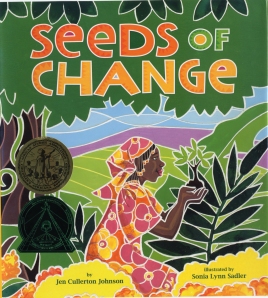
Seeds Of Change
In honor of Wangari Maathai’s birthday on Tuesday, April 1 and upcoming Earth Day later this month, we at Lee & Low Books want to share all the fantastic resources and ideas that are available to educators who are teaching about Wangari Maathai’s legacy and using Seeds Of Change: Planting a Path to Peace.

Seeds Of Change
Elementary School:
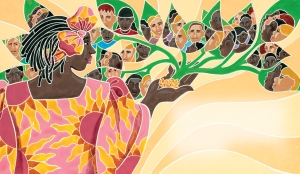 Middle School and High School:
Middle School and High School:
- Seeds Of Change won the American Library Association’s Coretta Scott King/John Steptoe Award for New Talent in Illustration in 2011. The Committee Chair and Book Jury have prepared activities and discussion questions for Seeds Of Change in the 2011 Discussion Guide for Coretta Scott King Book Awards, P. 20-21.
- Have students read and discuss author Jen Cullerton Johnson and illustrator Sonia Lynn Sadler’s joint interview with Lee & Low, which covers the environment, their travels, and Wangari Maathai’s achievements.
- After introducing Wangari Maathai with Seeds Of Change, delve deeper with the Speak Truth To Power human rights education curriculum, a project of the Robert F. Kennedy Center for Justice and Human Rights. They present an in-depth exploration on Wangari Maathai, the Green Belt Movement, and sustainability issues.
- In teaching standard 7 of the ELA Common Core, have students evaluate how Wangari Maathai is presented in a documentary compared to the Seeds Of Change biography. PBS’s documentary on Wangari Maathai and the Green Belt Movement, Taking Root: The Vision of Wangari Maathai, contains a classroom section full of video modules, handouts, and lesson plans.
What did we miss? Let us know how you are using Seeds Of Change in your classroom!
Filed under:
Curriculum Corner Tagged:
African/African American Interest,
biographies,
CCSS,
children's books,
common core standards,
diversity,
Educators,
ELA common core standards,
environmentalism,
History,
holidays,
lesson plans,
Reading Aloud,
reading comprehension,
ReadyGEN,
Wangari Maathai 

We were thrilled to see the announcement this week that architect Shigeru Ban has won the Pritzker Architecture Prize, one of architecture’s most important awards. Ban is notable not only for his inspired and gorgeous designs but for his humanitarian work using innovative architecture and renewable resources to help refugees and those affected by both man-made and natural disasters. Take a look at his paper tube school in China, featured in our book Dreaming Up: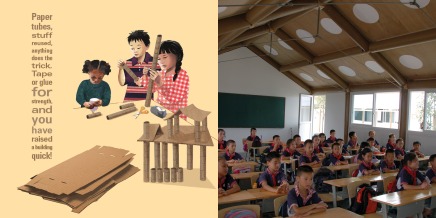
Teachers and students helped construct this temporary school out of plywood and recycled heavy-duty paper tubes after an earthquake destroyed many buildings in China’s Sichuan Province. Dreaming Up author and illustrator Christy Hale shares why she chose to include Shigeru Ban’s work in her book:
In selecting the architects and structures featured in Dreaming Up: A Celebration of Building I began by considering children’s building play. What materials do they use? Children do not need prepackaged toys; they can build from whatever is at hand. In fact using recyclables encourages two qualities enormously important in creativity: resourcefulness and flexibility—essential for the problem-solvers of tomorrow. After developing my list of children’s construction activities, I then looked for architects working with visually similar materials and design challenges. This is how I made my pairings.
The new Pritzker Architecture Prize-winner, Shigeru Ban said, “Anything can be building structure material.” Ban creates elegant designs from humble materials. He is famous for upcycling industrial strength paper tubes, shipping containers, and even tea bags!
I thought my young readers would particularly like his Paper Tube School in Chengdu, a temporary school built in 2008 with the help of teachers and students after an earthquake destroyed many buildings in China’s Sichuan Province. I also wanted to showcase Ban for his humanitarian work. His architecture efficiently serves the pressing needs of disaster victims while simultaneously honoring them with beauty.
Shigeru Ban’s approach to architecture makes a great entry point when introducing young people to the art form. Use these teaching resources along with Dreaming Up to inspire next generation of architects:
Recycled Building Hands-On Classroom Activity
Great Teaching Ideas for Dreaming Up from The Classroom Bookshelf
LEGO’s Read! Build! Play! Summer Reading List and Activity Guide
Filed under:
Curriculum Corner Tagged:
architecture,
dreaming up,
lesson plans,
Pritzker Prize,
Shigeru Ban,
teaching resources 

 Jill Eisenberg, our Resident Literacy Expert, began her career teaching English as a Foreign Language to second through sixth graders in Yilan, Taiwan as a Fulbright Fellow. She went on to become a literacy teacher for third grade in San Jose, CA as a Teach for America corps member. She is certified in Project Glad instruction to promote English language acquisition and academic achievement. In her column she offers teaching and literacy tips for educators.
Jill Eisenberg, our Resident Literacy Expert, began her career teaching English as a Foreign Language to second through sixth graders in Yilan, Taiwan as a Fulbright Fellow. She went on to become a literacy teacher for third grade in San Jose, CA as a Teach for America corps member. She is certified in Project Glad instruction to promote English language acquisition and academic achievement. In her column she offers teaching and literacy tips for educators.
Dissecting excerpts, highlighting evidence, defending one’s answer choice, bubbling in exit slips. As necessary as all that preparation for upcoming state assessments may be, March and April for teachers and students can be arduous. In some cases, students are learning how to take a test for the first time. For many, the third quarter risks turning enthusiastic momentum for reading, developing interests, and taking academic risks into a trudge of review and re-teaching.
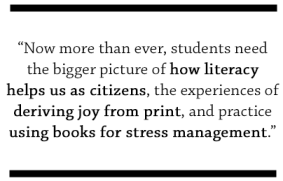 With all this reading in overdrive, it is understandable that few students (and teachers) want to keep reading at home for pleasure. Yet we need to sustain student excitement for reading and prevent testing anxiety. Now more than ever, students need the bigger picture of how literacy helps us as citizens, the experiences of deriving joy from print, and practice using books for stress management.
With all this reading in overdrive, it is understandable that few students (and teachers) want to keep reading at home for pleasure. Yet we need to sustain student excitement for reading and prevent testing anxiety. Now more than ever, students need the bigger picture of how literacy helps us as citizens, the experiences of deriving joy from print, and practice using books for stress management.

Where On Earth Is My Bagel?
If you have observed your students retreating from the idea that books are an escape and hobby to an unpleasant, stressful task, here are some techniques to increase the joy factor in reading and keep kids hooked:
- After lunch, recess, or the morning message, bring the class together to listen to you read a poem or a chapter from a longer book that is not connected to a skills or strategies lesson. This daily activity exposes students to books beyond their reading levels, bolsters classroom community in an otherwise competitive time, and communicates that books have calming, revitalizing effects.
- Continue to highlight books with relevant holidays, core value themes, or S.T.E.M. content using designated bins or book cover displays at child height. Even during crunch time when it is hard to infuse lessons with interdisciplinary connections and core value applications, these exhibitions or quick booktalks allow students to explore and develop their interests. Consider creating collections for Women’s History Month, Cesar Chavez Day, baseball season, National Poetry Month in April, and Earth Day.
- Lead students with books in arms to another classroom or outside for a “field trip.” This physical change of scenery reinforces that books are a mental change of scenery and a respite.
- Set aside 20 minutes every day just for independent reading instead of squeezing in one more skills mini-lesson. Preserving time for students to interact with books of their choice in independent reading allows students to take a break, manage tension, and re-focus their energy. During this time, students self-select books they enjoy, exercise literacy strategies, and feel in control of their learning. This commitment and preservation of independent reading time conveys to students how seriously you value and respect this sacred time to enjoy a book.

Ten Oni Drummers
- A lot of test preparation and review involves independent work and sitting quietly. For an end of the week reward, let students choose a classroom peer to read to instead of independent reading that day, invite a younger grade to your classroom for your students to read to, utilize siblings and family relationships at the school, or invite other stakeholders in your students’ educations (like the cafeteria or main office staff) to enjoy a book with students. Reading to someone (buddy reading) allows scholars a chance to talk, enjoy a book in a low-stakes environment, and escape to a new world in a wonderful story.
- Encourage parents to lead a whole-class read aloud in the classroom. This time gives you a chance to conference with struggling readers, celebrate parents as teachers, and encourage the intergenerational fellowship of books.
- Invite an author to school or hold an online interview . There is nothing quite like reinvigorating young readers and writers than with a real author. This bright treat gives students a badly needed broader perspective of books beyond assessments. For more information on how to bring authors into your unit of study no matter what your budget is, check out this post.
- Change up the routine! Have an “opposites day” in which two teachers switch for a read aloud/poem one day. Or engage other school community members (like the principal, school nurse, and other non-teaching staff) to read to the whole class so that your students can see that they have a whole team cheering for them and invested in their growth, health, and success.
Do your students need a distraction? These joyful books offer just enough silliness, escape, or suspense to remind students that books are also for entertainment!
Filed under:
Curriculum Corner Tagged:
CCSS,
children's books,
Reading Aloud,
reading comprehension 


By:
jilleisenberg14,
on 3/17/2014
Blog:
The Open Book
(
Login to Add to MyJacketFlap)
JacketFlap tags:
children's books,
History,
biography,
Educators,
white house,
reading comprehension,
close reading,
differentiation,
character analysis,
common core standards,
CCSS,
bloom's taxonomy,
Curriculum Corner,
guided reading,
rigor,
ELA common core standards,
higher level thinking,
Add a tag
 Jill Eisenberg, our Resident Literacy Expert, began her career teaching English as a Foreign Language to second through sixth graders in Yilan, Taiwan as a Fulbright Fellow. She went on to become a literacy teacher for third grade in San Jose, CA as a Teach for America corps member. She is certified in Project Glad instruction to promote English language acquisition and academic achievement. In her column she offers teaching and literacy tips for educators.
Jill Eisenberg, our Resident Literacy Expert, began her career teaching English as a Foreign Language to second through sixth graders in Yilan, Taiwan as a Fulbright Fellow. She went on to become a literacy teacher for third grade in San Jose, CA as a Teach for America corps member. She is certified in Project Glad instruction to promote English language acquisition and academic achievement. In her column she offers teaching and literacy tips for educators.
First Lady Michelle Obama travels to China this week from March 19-26 and will be focusing on the power and importance of education. In an open letter to American students, the First Lady writes, “During my trip, I’ll be visiting a university and two high schools in Beijing and Chengdu (which are two of China’s largest cities). I’ll be talking with students about their lives in China and telling them about America and the values and traditions we hold dear. I’ll be focusing in particular on the power and importance of education, both in my own life and in the lives of young people in both of our countries.”
We at Lee & Low Books wish we could join the First Lady, but since we can’t this time around, we will be reading the biography of one of China’s greatest statesmen, poets, and humanitarians, Su Dongpo. This scholar is a shining example of how persistence and dedication to one’s studies lead to achievement beyond the classroom and enable one to affect meaningful change.

Su Dongpo, Chinese Genius
This biography presents a rich setting for Standard 3 of the Common Core State Standards: character analysis. We follow Bloom’s Taxonomy to illustrate the range of questions you can use to meet your students’ needs and access their literary strengths. By creating a progression of questions within one standard, we differentiate for students within a class, provide extension opportunities for ready learners, or move the whole class from literal- to higher-level thinking over the course of several readings.
Knowledge:
- What are Su Dongpo’s appearance/physical attributes, deeds/actions, thoughts/dialogue, and feelings/emotions?
- What are other character’s opinions of and reactions to Su Dongpo?
- Can you select sections showing how Su Dongpo relates to other characters?
- How would you describe Su Dongpo in a paragraph?
Comprehension:
- How would you classify Su Dongpo’s character trait(s) based on these actions, thoughts, and feelings above?
- How would you summarize Su Dongpo’s opinion or feelings about Wang Anshi?
- How would you describe Su Dongpo’s feelings about being banished from his job and home?
- What problems does Su Dongpo face and how does he solve them?
- How would you summarize Su Dongpo’s opinion about the purpose of government?
Application:
- When Su Dongpo was twenty, he took the official exams and earned status as the First Scholar for his academic achievements. Based on what you know about Su Dongpo’s character traits, how would he have handled the situation differently if he had not earned such high marks the first time?
- How would Su Dongpo react if his brother, Su Ziyou, became a corrupt government official?
- What would need to happen or change for Su Dongpo to work for Emperor Zhezong?
- How would Su Dongpo distinguish a “good” government from a “bad” government?
- What would Su Dongpo likely think about our end of the year state assessments or the Common Core State Standards?
- What advice do you think Su Dongpo would have for students who take state and national tests today?
- If Su Dongpo worked for the U.S. Department of Education, what might Su Dongpo feel and think about the role of education in America today?
Analysis:
- How did Su Dongpo’s upbringing prepare him for his career in government?
- What inspired Su Dongpo’s beliefs about the purpose of government?
- Why did Su Dongpo not care about “instant glory” or “worldly fame” when making a decision?
- Compare Su Dongpo and Wang Anshi’s motivations for working in the government.
Synthesis:
- Compose and present a speech that will communicate the thoughts and feelings of Su Dongpo to the Chinese people after he is pardoned when Emperor Zhezong dies.
- Imagine you are Su Dongpo and write a diary account of your daily thoughts and activities. What would you say about the work that you do, the people you meet in government and in the villages, and the challenges you face?
- Rewrite the scene of Su Dongpo hearing he is pardoned after the death of Emperor Zhezong. What would Su Dongpo feel and what would the Chinese people think about him if he were not pardoned?
Evaluation:
- Defend whether you would or would not like Su Dongpo to work in your government.
- Argue what lessons Su Dongpo learned from his career in and out of government.
- How effective is Su Dongpo as a humanitarian?
- Determine whether Su Dongpo was or was not disrespectful of government.
- Assess whether Su Dongpo changed from the beginning to the end of the book based on his character traits.
Additional resources:
Sign up for updates from the First Lady throughout her trips and opportunities to ask questions.
Explore PBS LearningMedia for the First Lady’s blog, a map of China, and other resources.
Filed under:
Curriculum Corner Tagged:
biography,
bloom's taxonomy,
CCSS,
character analysis,
children's books,
close reading,
common core standards,
differentiation,
Educators,
ELA common core standards,
guided reading,
higher level thinking,
History,
reading comprehension,
rigor,
white house 


By:
jilleisenberg14,
on 3/10/2014
Blog:
The Open Book
(
Login to Add to MyJacketFlap)
JacketFlap tags:
children's books,
holidays,
History,
diversity,
Reading Aloud,
reluctant readers,
women's history month,
Educators,
Wangari Maathai,
women in history,
Curriculum Corner,
Girls/women,
Add a tag
 Jill Eisenberg, our Resident Literacy Expert, began her career teaching English as a Foreign Language to second through sixth graders in Yilan, Taiwan as a Fulbright Fellow. She went on to become a literacy teacher for third grade in San Jose, CA as a Teach for America corps member. She is certified in Project Glad instruction to promote English language acquisition and academic achievement. In her column she offers teaching and literacy tips for educators.
Jill Eisenberg, our Resident Literacy Expert, began her career teaching English as a Foreign Language to second through sixth graders in Yilan, Taiwan as a Fulbright Fellow. She went on to become a literacy teacher for third grade in San Jose, CA as a Teach for America corps member. She is certified in Project Glad instruction to promote English language acquisition and academic achievement. In her column she offers teaching and literacy tips for educators.

Irena’s Jars Of Secrets
I entered the education field to broaden the minds of a new generation and teach the truths that I felt I had missed or was denied in my own education. Indeed, I was not alone in those motivations. According to the Primary Sources project by Scholastic and the Bill & Melinda Gates Foundation, of the more than 20,000 public school classroom teachers polled, 85% of teachers say they chose the profession in order to make a difference in children’s lives.
Despite my righteous ambitions, once in the classroom, I was hesitant to broach the conversation about gender with a mixed class of boys and girls. So many of my own college classes that focused on social justice and equality issues were almost entirely women.
Acutely aware of my students’ fragile perception of themselves, I was intimated by the prospect of guiding the discussion. When I was leading a classroom of my own, it was often easier to concentrate on the benign world of synonyms, dictionary skills, main idea, and genre features than push my students to think about what role gender plays in achievement, history, and identity.
I wondered: How do we teach about women’s history and contributions without alienating boys? Will boys disengage if a girl or woman is on the cover or is the main character? In this day and age, do girls still need explicit attention drawn to high-achievers that share their gender?
Leading up to my first month of March as a teacher, I thought I would “just” read more books with women as the central figures during Women’s History Month, but not explicitly point out that these were all women so as not to freak out boys and hope the girls would pick up on my subliminal messages of empowerment….

Insert face palm here.
This thinking was a huge disservice to ALL of my students’ educations. As I introduced books with prominent women historic figures or girl characters, I realized if the books were about gender, we would discuss identity and tolerance. Other times if the story just happened to have a girl character, but gender wasn’t a central feature of the story, my scholars just wanted to focus on the great story and how the universal lessons applied to their lives.
Four lessons to think about when teaching women’s history so both boys AND girls grow and learn:
- Two words: cool stories. Above all, if it’s a great story, it doesn’t matter who is on the cover. Everyone will want to sit up and participate.
- Pick contemporary and diverse stories. To continue to show the relevancy of the women’s movements and contributions of women to society, we owe it to all of our students to find more contemporary examples of women figures and showcase more diverse participants in equality. Let’s keep exposing our kids to women of today and of different backgrounds.
- Show explicit examples of men championing women. Boys need to see great role models of men advocating for women alongside or behind the scenes. There are plenty of men who have been in the trenches with women fighting for social
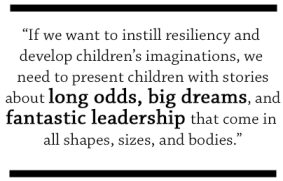 justice and as invested in their wives, daughters, sisters, and mothers achieving great success in a field of study as the women themselves. If we want future generations of men to respect and support women, we need to offer boys examples of how to recognize and champion women’s contributions. Boys and girls need to see that the struggles for equality impacted everyone and were not about one group’s success at the other’s detriment.
justice and as invested in their wives, daughters, sisters, and mothers achieving great success in a field of study as the women themselves. If we want future generations of men to respect and support women, we need to offer boys examples of how to recognize and champion women’s contributions. Boys and girls need to see that the struggles for equality impacted everyone and were not about one group’s success at the other’s detriment.
- Talk about the universal lesson and character traits. Everyone can learn from a story about overcoming obstacles, persistence, and courage. Women like Wangari Maathai and Pura Belpré fought for what they loved and believed was right first, and then fought for who they were and who they represented. If we want to instill resiliency and develop children’s imaginations, we need to present children with stories about long odds, big dreams, and fantastic leadership that come in all shapes, sizes, and bodies.
Throughout the year and especially during Women’s History Month, we need to teach that gender shouldn’t be an excuse to bar someone from exploring or contributing to a field of study. Concurrently, we want to show all students that gender can offer a unique perspective or approach that should be recognized and celebrated.
Alongside our girls, boys need the language of equality and a broader view of history. Women’s contributions advanced our society and continue to impact all of us. We need to teach that gender totally does matter and, at the same time, totally doesn’t matter.

Shining Star: The Story Of Anna May Wong
Susan B. Anthony Is Great, But Who Else Do We Have? Here are books about high-achieving women from diverse backgrounds with diverse pursuits.

Baby Flo: Florence Mills Lights Up The Stage
Women and The Men That Championed Them. Explore these books with awesome men celebrating awesome women:

Killer Of Enemies
Stories That Will Hook ’Em All. Here are stories so fun that it won’t matter who is on the cover…but the cover just happens to feature a girl:
Filed under:
Curriculum Corner Tagged:
children's books,
diversity,
Educators,
Girls/women,
History,
holidays,
Reading Aloud,
reluctant readers,
Wangari Maathai,
women in history,
women's history month 


By:
jilleisenberg14,
on 3/3/2014
Blog:
The Open Book
(
Login to Add to MyJacketFlap)
JacketFlap tags:
Educators,
reading comprehension,
close reading,
CCSS,
Curriculum Corner,
ELA common core standards,
children's books,
diversity,
Reading Aloud,
Add a tag
 Jill Eisenberg, our Resident Literacy Expert, began her career teaching English as a Foreign Language to second through sixth graders in Yilan, Taiwan as a Fulbright Fellow. She went on to become a literacy teacher for third grade in San Jose, CA as a Teach for America corps member. She is certified in Project Glad instruction to promote English language acquisition and academic achievement. In her column she offers teaching and literacy tips for educators.
Jill Eisenberg, our Resident Literacy Expert, began her career teaching English as a Foreign Language to second through sixth graders in Yilan, Taiwan as a Fulbright Fellow. She went on to become a literacy teacher for third grade in San Jose, CA as a Teach for America corps member. She is certified in Project Glad instruction to promote English language acquisition and academic achievement. In her column she offers teaching and literacy tips for educators.

Home to Medicine Mountain
My students and their siblings were often alone or spent a lot of time with each other. For some, siblings were the only constant in their lives. Fittingly, siblings and close-in-age relatives held powerful sway and influence over each other.
I found that brothers, sisters, cousins, and neighbors saw each other’s success as their OWN success. One of my third-graders danced in the middle of the carpet for twelve minutes after he heard the intercom announcement that his fifth-grade sister would be the new school president of the student council. What if I could channel that excitement towards literacy?
Brothers and sisters WANTED to see their siblings succeed. Sure, when one of my third-graders struggled to translate from English to Spanish that she hadn’t turned her homework in for a week at the parent-teacher conference, her older sister was delighted to impart the correct information to their mother.
In addition to using siblings for accountability and parent-teacher bridges, siblings became an incredible reward and relationship in my classroom. When my students, especially the struggling readers, made it to a new level, aced an assessment, or turned in excellent high-quality work, I wrote laudatory notes and let those students deliver them to their siblings in another classroom.

Mama Elizabeti
This system turned out to be just as powerful as a celebratory phone call home to adults, but I was recognizing the child in real time and recognizing the strength of the family presence at school. And it went further: the younger or older sibling was able to celebrate my student in their classroom and admire them publicly amidst their peers for academic achievement. There are not enough Dollar Tree prizes to compete with that kind of reward.
Beyond my school, psychologists have noticed the effect older brothers and sisters can have. In fact, NPR explored the positive and negative consequences of older sibling influence in a segment called, “Big Sibling’s Big Influence: Some Behaviors Run In The Family.”
At Arlington Elementary in Arlington, Tennessee, The Jackson Sun reported how teachers are recruiting older students to read to younger students in their Big Brothers, Big Sisters Reading Club every morning before school. More advanced students can relate to struggling readers and explain strategies in a friendly, non-high-stakes atmosphere.
In Carmel Valley, California, the Read To Me Project is an early literacy program that builds school readiness by engaging elementary brothers and sisters to read to their siblings. So far, 350 participating older siblings are reading to 443 young children across four school districts.
For Dr. Seuss’ Birthday last year at my school in the Bay Area, our kindergarten teachers invited the third-graders to read to them. Everyone was ecstatic to read to their brother, sister, cousin, or neighbor. My scholars had the opportunity to show off the chapter books they were tackling and feel like experts as they helped the kinders decode and recognize sight words. The kinders, in turn, received extra reading time, exposure to high-quality texts, and an opportunity to show off how remarkable their older sibling was.
One of my students who was an advanced learner, but had a very unstable home life, was very, very protective of his three younger brothers. His active kinder brother had refused to read with any third-grader, hiding each time another class of third-graders came throughout the day. Not until the last period arrived and his third-grade brother, my student, finally appeared did this kinder cuddle up to read. Even though my student brought a dense, picture-less chapter book on sharks and their presence in Fiji cultural traditions, his kinder brother sat in rapt attention for nearly an hour soaking in every word from his big brother.
We know the results on a child’s motivation and confidence when parents relish in their child’s success, so why don’t we harness that effect from siblings as well? Equipping our children with the love for reading and the skills needed to confront real world problems involves every stakeholder in our children’s lives—and that may include their smallest (but loudest!) cheerleaders.
If you need more inspiration, check out these books with strong sibling relationships:

Summer of the Mariposas
Filed under:
Curriculum Corner Tagged:
CCSS,
children's books,
close reading,
diversity,
Educators,
ELA common core standards,
Reading Aloud,
reading comprehension 


By:
jilleisenberg14,
on 2/26/2014
Blog:
The Open Book
(
Login to Add to MyJacketFlap)
JacketFlap tags:
History,
diversity,
Oscars,
Educators,
reading comprehension,
infographics,
Academy Awards,
Race issues,
common core standards,
CCSS,
visual literacy,
teaching about race,
Curriculum Corner,
ELA common core standards,
Add a tag
 Jill Eisenberg, our Resident Literacy Expert, began her career teaching English as a Foreign Language to second through sixth graders in Yilan, Taiwan as a Fulbright Fellow. She went on to become a literacy teacher for third grade in San Jose, CA as a Teach for America corps member. She is certified in Project Glad instruction to promote English language acquisition and academic achievement. In her column she offers teaching and literacy tips for educators.
Jill Eisenberg, our Resident Literacy Expert, began her career teaching English as a Foreign Language to second through sixth graders in Yilan, Taiwan as a Fulbright Fellow. She went on to become a literacy teacher for third grade in San Jose, CA as a Teach for America corps member. She is certified in Project Glad instruction to promote English language acquisition and academic achievement. In her column she offers teaching and literacy tips for educators.
Infographics’ format and economy of words make infographics engaging and accessible to children, reluctant readers, visual learners, and English Language Learners. As infographics contain multiple layers of information, they are a challenging medium for students to practice inferences and interpretation. Lee & Low Books’ infographic series on the diversity gap in major spheres of influence is a valuable vehicle to build students’ visual literacy skills and understanding of diversity. The following discussion questions and suggested activities were created based on the Diversity Gap in the Academy Awards infographic, but these can be applied to the rest of the series.
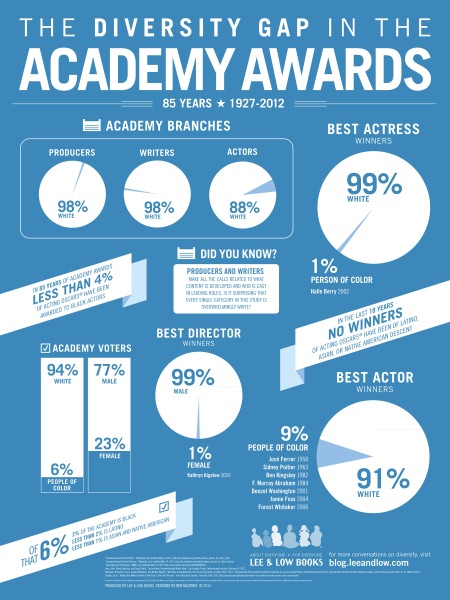
Infographic: The Diversity Gap in the Academy Awards (click to enlarge)
Discussion questions to consider with your students:
- What patterns do you see? What trends do you see? How are the different charts related?
- What is the central idea of this infographic? How do the words, phrases, and visuals interact to affirm the central idea?
- Based on the infographic, what does “diversity gap” mean in terms of the Academy Awards?
- What might the author’s purpose be in choosing this medium to convey the central idea (to shame, inspire, shock, etc.)?
- Does the infographic make the central idea clear and obvious? How does the infographic use an economy of words, language, typography, pie charts, bar graphs, negative space, and title to communicate the central idea?
- What type of infographic is this (flow chart, web, map, graph, diagram, table, timeline)? What might the author’s purpose be in choosing this type of infographic? How effective is this format of infographic at organizing and displaying data compared to just text?
- Evaluate the effectiveness of the infographic as a form of communication as compared to text alone. Is this the most effective and convincing way to convey information about a lack of diversity at the Academy Awards? Why or why not?
- Why might the creators have assembled this information about the Academy Awards and race at all?
- Who is the intended audience (moviegoers, actors, directors, writers, producers, movie studios, general public, government officials)? What might the creators of this infographic want them to do with this information?
- What is the context of this infographic? What major events in the United States were taking place when this infographic was created? Why is it important to understand the context of the infographic?
- Is this infographic’s argument and presentation persuasive or compelling? Why or why not? Analyze this infographic’s effectiveness in inspiring activism.
- Based on the information presented, what can you predict future trends will be for award winners, actors, directors, producers, and writers?
- Can you determine causes for the lack of diversity in this infographic? Why or why not? How might researchers go about figuring out the cause(s) for the historical and current lack of diversity in the Academy Awards?
- What is the impact of a lack of diversity amongst writers, actors, producers, directors, and award winners? What does it mean to be a young child growing up and consuming this form of media (movies)? What will they see? What will they not see? Tell me more about the possible effects of this situation and current trends.
Suggested activities:
- Challenge students to translate this infographic’s central idea into a written argument. Students should use key details and evidence from the infographic to assert the central idea.
- Have students revise or add on to make the infographic more effective. Students should consider format, adding or deleting information, and more. What would make the infographic stronger, more persuasive, or more memorable?
- Encourage students to investigate how these percentages compare to the general public. Students can use the United States Census data for demographics.
- Have students investigate possible causes for the lack of diversity in the Academy Awards. Urge students to propose ways to change these trends.
- If possible, ask students to research the percent of moviegoers who are people of color. Check industry publications or major news periodicals. How do these numbers compare to the information in the infographic?
- Permit students to interview their grade, class, or school on questions, including: Do you go to the movies? How often? What kinds of movies do you see? Who are your favorite actor and actress in Hollywood today? Who is a director/actor/actress of color that you have seen in a movie recently? Why do you think there aren’t more movies by and with people of color? Students can organize and display data in graphs and present findings to the class. Reflect on this information’s relationship to the infographic’s central idea.
- Dig deeper—investigate the artists that were nominated each year. How many were people of color over those 85 years? What roles did these artists play in the movies they were nominated for? What genres of movies were they in for this nomination? Explore the people of color who did win best actress or best actor. What roles did they play and what kind of movies were they in when they won for best acting?
- Compare this to other Lee & Low Books’ infographics in the series: The Tony Awards, The Emmy Awards, Children’s Book Publishing, The NY Times Top 10 Bestsellers List, and American Politics. Consider central idea, evidence, format, and audience.
- Update the information to include the 2013 and 2014 Academy Awards results. What changed? What did not change?
For further reading on teaching visual literacy and diversity in the classroom, check out these fantastic resources:
How are you building visual literacy skills in the classroom? Let us know below!
Filed under:
Curriculum Corner Tagged:
Academy Awards,
CCSS,
common core standards,
diversity,
Educators,
ELA common core standards,
History,
infographics,
Oscars,
Race issues,
reading comprehension,
teaching about race,
visual literacy 


 Katherine Ali is a dual-certified elementary and special education teacher. She recently graduated as a literacy specialist with a Masters in Science from Manhattanville College. She has experience teaching internationally in northern China and now teaches in the Bronx, NY.
Katherine Ali is a dual-certified elementary and special education teacher. She recently graduated as a literacy specialist with a Masters in Science from Manhattanville College. She has experience teaching internationally in northern China and now teaches in the Bronx, NY.
In order to be active participants in the literate world, students must be reading, writing, speaking, and listening at all ages. The natural interplay of language looks slightly differently across grades levels, but the foundations and mission are the same:
Reading: Text Complexity and the growth of comprehension
We want our students to ascend the staircase of text complexity and simultaneously sharpen their comprehension skills. Students, of all ages, need to build stamina through independently reading more rigorous and complex texts. Additionally, read-alouds allow students to access content and concepts they may not be able to decode themselves.
Writing: Text types, responding to reading, and research
Opinion pieces, research-based projects, and narratives are the three main categories of student writing the Common Core State Standards focus on. It is also imperative that our students engage in the writing process and expand their writing style using the conventions of the English language.
Speaking & Listening: Flexible Communication and Collaboration
Speaking and Listening in each grade level includes but is certainly not limited to presentations, group work, and class discussion. Students need to be aware of their oral language skills and communicate their thoughts and research appropriately. Building off other students’ ideas is also an important component in developing these skills.
In this series, I’ve looked at:
Integrating reading, writing, speaking, and listening in grades K-1
Integrating reading, writing, speaking, and listening in grades 2-3
Today I look at how to integrate reading, writing, speaking and listening standards in grades 4-5, using the book Bird as an example.
 Bird, by Zetta Elliott, illus. by Shadra Strickland
Bird, by Zetta Elliott, illus. by Shadra Strickland
Interest Level: Gr. 3-8
DRA: 40, Guided Reading Level: Q
Reading: Due to some heavy content (drug use and addiction, death) this story must be used in a safe learning environment. It allows for great discussion around the themes of death, decision-making, perseverance, and coping skills. Reading this book closely with a small group of students – almost page by page – will allow the students to deeply recognize the narrator’s point of view and how it affects the story. Character description and point of view are the two main reading strategies I would suggest teaching with this intense, powerful text.
Writing: Quick writes about students’ reactions and connections to the story are still merited in fourth and fifth grade. Higher-level thinking questions can also be posed for students to develop their inferential thinking skills as well as their ability to cite evidence to support their answer. Questions can include, “How are birds important in this text?” “What happened to Marcus? How do you know? What in the story tells you this?” and “How do you feel about the ending? Why?“ Using a high-interest and provocative book such as Bird may elicit a higher level of student participation.
Speaking & Listening: To engage the students immediately, introduce this story by showing the Book Trailer posted on the Lee and Low website. After students read and listen to the trailer, have them turn and talk with a partner to make predictions. Or you can pose the question, “How does this trailer make you want to read the book Bird?” and give students 5 – 10 minutes for a quick write and share. Then, discuss the media medium of the trailer asking, “Whose perspective is the story being told from? How do you know? What decisions did the editor have to make? How do the music and transitions affect the presentation?” The S&L standards for these grades want the students to converse about multimedia and presentation decisions.
There is also an extensive free teacher’s guide available to go with Bird, with several additional ideas.
Notice the close relationship between the modes of communication as the students read, listen to, write, and speak about complex, grade-appropriate texts. If these key features are central to your instruction, your students will leave with a toolbox of skills they can rely on forever.
Filed under:
Curriculum Corner Tagged:
Bird,
CCSS,
common core standards,
ELA common core standards,
listening and speaking standards,
Reading Standards,
writing standards 


By:
Hannah,
on 9/16/2013
Blog:
The Open Book
(
Login to Add to MyJacketFlap)
JacketFlap tags:
common core standards,
CCSS,
Curriculum Corner,
ELA common core standards,
listening and speaking standards,
Reading Standards,
writing standards,
reading,
Civil Rights,
guest blogger,
integration,
close reading,
Add a tag

 Katherine Ali is a dual-certified elementary and special education teacher. She recently graduated as a literacy specialist with a Masters in Science from Manhattanville College. She has experience teaching internationally in northern China and now teaches in the Bronx, NY.
Katherine Ali is a dual-certified elementary and special education teacher. She recently graduated as a literacy specialist with a Masters in Science from Manhattanville College. She has experience teaching internationally in northern China and now teaches in the Bronx, NY.
In order to be active participants in the literate world, students must be reading, writing, speaking, and listening at all ages. The natural interplay of language looks slightly differently across grades levels, but the foundations and mission are the same:
Reading: Text Complexity and the growth of comprehension
We want our students to ascend the staircase of text complexity and simultaneously sharpen their comprehension skills. Students, of all ages, need to build stamina through independently reading more rigorous and complex texts. Additionally, read-alouds allow students to access content and concepts they may not be able to decode themselves.
Writing: Text types, responding to reading, and research
Opinion pieces, research-based projects, and narratives are the three main categories of student writing the Common Core State Standards focus on. It is also imperative that our students engage in the writing process and expand their writing style using the conventions of the English language.
Speaking & Listening: Flexible Communication and Collaboration
Speaking and Listening in each grade level includes but is certainly not limited to presentations, group work, and class discussion. Students need to be aware of their oral language skills and communicate their thoughts and research appropriately. Building off other students’ ideas is also an important component in developing these skills.
Last week, I explained what what it looks like to integrate reading, writing, speaking, and listening in grades K-1, using the book Rainbow Stew as an example. This week, I take a look at grades 2-3:
 As Fast As Words Could Fly by Pamela M. Tuck, illus. by Eric Valesquez
As Fast As Words Could Fly by Pamela M. Tuck, illus. by Eric Valesquez
Interest Level: 2 -7
DRA: 34, Guided Reading Level: O
Reading: Doing a close read with students of As Fast As Words Could Fly fulfills the Common Core’s shift up the staircase of text complexity and builds strong vocabulary skills. Words such as refused, boasted, disbelief, barricaded, grimaces, and blurted are rich and valuable for second and third graders to read and understand. This text is also an excellent model of the use of dialogue. Through close reading activities students can highlight the dialogue and the speaker to understand the different ways to properly punctuate dialogue in a narrative. Of course, teachers can also read this story aloud so students can connect to the themes of perseverance and overcoming adversity.
Writing: Tuck’s writing style is strong and complex. She uses compound sentences, prepositions, and onomatopoeia throughout the story creating a very sophisticated narrative. Teachers can focus on one of these skills in a Writing Workshop model in which students translate the skill into their own writing. Mason’s story also evokes different opinions and feelings that lead to rich discussion. Use these discussion questions as a guide and encourage students to write a Reader’s Response and to share their responses 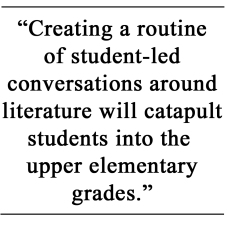 with the class.
with the class.
Speaking & Listening: By second and third grade, students should be developing their formal presentation skills, therefore they may share Mason’s story through a presentation about influential people who took risks (complement the study with this interview with Moses Teel Jr., whose experience as a teenager during integration was the basis for Mason’s story).
Students also need to learn to lead discussions. Assign a group of students to be the leaders of an interactive read-aloud and have them come prepared with various questions they developed in advance with the classroom teacher. Creating a routine of student-led conversations around literature will catapult students into the upper elementary grades.
Stay tuned next week, when I discuss how to integrate reading, writing, speaking, and listening standards for grades 4-5 using Bird.
Filed under:
Curriculum Corner,
guest blogger Tagged:
CCSS,
Civil Rights,
close reading,
common core standards,
ELA common core standards,
integration,
listening and speaking standards,
reading,
Reading Standards,
writing standards 


By:
Hannah,
on 9/9/2013
Blog:
The Open Book
(
Login to Add to MyJacketFlap)
JacketFlap tags:
common core standards,
CCSS,
Curriculum Corner,
ELA common core standards,
listening and speaking standards,
Rainbow Stew,
Reading Standards,
writing standards,
literacy,
guest blogger,
kindergarten,
reading comprehension,
close reading,
Add a tag

 Katherine Ali is a dual-certified elementary and special education teacher. She recently graduated as a literacy specialist with a Masters in Science from Manhattanville College. She has experience teaching internationally in northern China and now teaches in the Bronx, NY.
Katherine Ali is a dual-certified elementary and special education teacher. She recently graduated as a literacy specialist with a Masters in Science from Manhattanville College. She has experience teaching internationally in northern China and now teaches in the Bronx, NY.
As educators, we witness the transformations of students throughout elementary school. First graders will one day become fifth graders, while fifth graders were once first graders. So we must think, where did our students come from? and where are they going next? Our classroom must be structured to prepare our students for the future and help them build a skillset they can bring with them. In order to be active participants in the literate world, students must be reading, writing, speaking, and listening at all ages.
Here on the LEE & LOW blog, I’ll illustrate what it looks like to integrate reading, writing, speaking, and listening across several grade levels: K-1, 2-3, and 4-5. The natural interplay of language looks slightly different across grade levels, but the foundations and mission are the same.
Reading: Text Complexity and the growth of comprehension
We want our students to ascend the staircase of text complexity and simultaneously sharpen their comprehension skills. Students of all ages need to build stamina through independently reading more rigorous and complex texts. Additionally, read-alouds allow students to access content and concepts they may not be able to decode themselves.
Writing: Text types, responding to reading, and research
The three main categories of student writing the standards focus on are opinion pieces, research-based projects, and narratives. It is also imperative that our students engage in the writing process and expand their writing style using the conventions of the English language.
Speaking and Listening: Flexible Communication and Collaboration
Speaking and Listening in each grade level includes (but is certainly not limited to) presentations, group work, and class discussion. Students need to be aware of their oral language skills and communicate their thoughts and research appropriately. Building off other students’ ideas is also an important component in developing these skills.
Over the next few weeks, I’ll share a few titles published by LEE & LOW BOOKS that illustrate opportunities for integrating oral and written language in the classroom. The stories can be used in different capacities depending on students’ interest and ability; therefore I focus on the interest level as well as the guided reading level to determine each book’s grade-level appropriateness. Furthermore, while the mini-lesson ideas and strategy-based activities are categorized by each key feature, they are still connected.
Grades K-1
Rainbow Stew by Cathryn Falwell
Interest Level: Grades K -3
DRA: 16, Guided Reading: I
Reading: The rhythm and rhyming of Rainbow Stew (“Whimper, sigh, cloudy sky, is it to wet to play? We don’t want to stay inside/ because of rain today“) make it a fantastic read aloud. Teachers can model how to use the bright, colorful pictures and other context clues to unlock the meaning of unfamiliar words such as “soggy” and “grasshopper.”
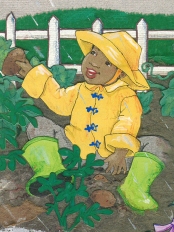
image from Rainbow Stew
Students can also practice reading together through choral reading exercises in either whole class or small group instruction. Choral reading supports struggling readers and strengthens fluency. Students are also then listening to the rhythm and rhyming of the author’s words repeatedly. Additionally, students may be able to read this story independently to practice fluency and build vocabulary. For emergent readers, this text can be a tool to teach phonemic awareness and word patterns as well.
Writing: Author Cathryn Falwell uses a methodical writing style of action words followed by rhyming verses. Young learners can discuss the writer’s craft in this picture book as well as notice some nuances in the different verses with strong scaffolding. Teachers can lead a shared writing project in which the class borrows Falwell’s style and writes their own book, playing with words. Another age-appropriate reading and writing strategy presented in Rainbow Stew is sequencing. Students will need to refer to the story in order to recount the events by either drawing pictures or writing.
Speaking & Listening: Teachers can facilitate an interactive read-aloud in which students turn and talk to one another about the story. Asking questions such as, “What other stories does Rainbow Stew remind you of?” adheres to the reading standards in making connections across different texts and fosters intentional discussions. Through the choral reading exercise students are reading, speaking, and listening to the text. Creating a class book improves collaboration skills such as taking turns, listening to other’s ideas, and compromising.
Stay tuned next week as I demonstrate how to integrate reading, writing, speaking & listening for grades 2-3 using As Fast As Words Can Fly by Pamela Tuck!
Further Reading:
Integrating Reading, Writing, Speaking, and Listening in the Classroom
What Does Close Reading Look Like in Kindergarten?
Filed under:
Curriculum Corner,
guest blogger Tagged:
CCSS,
close reading,
common core standards,
ELA common core standards,
kindergarten,
listening and speaking standards,
literacy,
Rainbow Stew,
reading comprehension,
Reading Standards,
writing standards 


By:
Jaclyn DeForge,
on 3/18/2013
Blog:
The Open Book
(
Login to Add to MyJacketFlap)
JacketFlap tags:
common core standards,
Curriculum Corner,
common core text sets,
text sets,
compiling rigorous text sets,
thematic text sets,
Book Lists,
Resources,
Reading Aloud,
close reading,
Add a tag
 Jaclyn DeForge, our Resident Literacy Expert, began her career teaching first and second grade in the South Bronx, and went on to become a literacy coach and earn her Masters of Science in Teaching. In her column she offers teaching and literacy tips for educators. This is the second in a series of posts on thematic text sets.
Jaclyn DeForge, our Resident Literacy Expert, began her career teaching first and second grade in the South Bronx, and went on to become a literacy coach and earn her Masters of Science in Teaching. In her column she offers teaching and literacy tips for educators. This is the second in a series of posts on thematic text sets.
One aspect of the Common Core that I get asked questions about all the time is thematic text sets. What are they? How do you know which books to use? What types of texts should you be pairing together?
Fear not! I’ve compiled some examples of text sets that cover one topic and span multiple genres and reading levels. Some of the titles you may already have in your classroom library, and others I think you’ll enjoy discovering. In my first post, I compiled books about the moon. Today we look at books about Kenya:
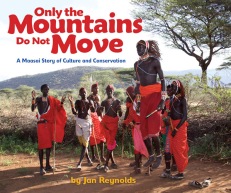
Theme/topic: Kenya
Grade: 3rd-4th
Informational Text: Only the Mountains Do Not Move by Jan Reynolds (Guided or Shared Reading)
- provides information about the Maasai people of Kenya
- can be used to address informational text standards
(a free Teacher’s Guide is available for this title)
Realistic Fiction: First Come the Zebra by Lynne Barasch (Independent Reading)
- the main characters in the story are from the Kikuyu and Maasai tribes
- can be used to address literature standards
(a free Teacher’s Guide is available for this title)
Narrative Nonfiction: Brothers in Hope: The Story of the Lost Boys of Sudan by Mary Williams (Read Aloud)
- the story chronicles the Lost Boys’ journey from southern Sudan to Kenya
- can be used to address informational text and literature standards
(a free Teacher’s Guide is available for this title)
Biography: Seeds of Change: Planting a Path to Peace by Jen Cullerton Johnson (Read Aloud)
- discusses the life and contributions of Nobel Peace Prize winner Wangari Maathai
- can be used to address informational text and literature standards
(a free Teacher’s Guide is available for this title)
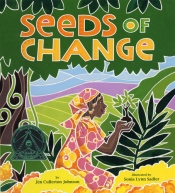
What books would you put on this list? Add your favorites in the comments!
Further Reading: Thematic Text Set: The Moon (2nd grade)
Filed under:
Curriculum Corner,
Resources Tagged:
Book Lists,
close reading,
common core standards,
common core text sets,
compiling rigorous text sets,
Reading Aloud,
text sets,
thematic text sets 


By:
Jaclyn DeForge,
on 3/4/2013
Blog:
The Open Book
(
Login to Add to MyJacketFlap)
JacketFlap tags:
fiction,
Book Lists,
Resources,
Reading Aloud,
Jane Yolen,
Read Aloud,
realistic fiction,
Nonfiction poetry,
independent reading,
Caroline Hatton,
reading comprehension,
literacy tips,
Marilyn Singer,
shared reading,
Gail Gibbons,
common core standards,
Owl Moon,
Curriculum Corner,
A Full Moon is Rising,
guided reading,
informational text,
common core text sets,
Surprise Moon,
text sets,
The Moon Book,
Add a tag
 Jaclyn DeForge, our Resident Literacy Expert, began her career teaching first and second grade in the South Bronx, and went on to become a literacy coach and earn her Masters of Science in Teaching. In her column she offers teaching and literacy tips for educators.
Jaclyn DeForge, our Resident Literacy Expert, began her career teaching first and second grade in the South Bronx, and went on to become a literacy coach and earn her Masters of Science in Teaching. In her column she offers teaching and literacy tips for educators.
One aspect of the Common Core that I get asked questions about all the time is thematic text sets. What are they? How do you know which books to use? What types of texts should you be pairing together?
Fear not! I’ve compiled some examples of text sets that cover one topic and span multiple genres and reading levels and over the next few weeks, I’ll be sharing these sets with you. Some of the titles you may already have in your classroom library, and others I think you’ll enjoy discovering.

Theme/topic: The Moon
Grade: 2nd
Informational Text: The Moon Book by Gail Gibbons (Shared Reading)
- provides scientific information about the moon
- can be used to address informational text standards
Nonfiction Poetry: A Full Moon is Rising by Marilyn Singer (Read Aloud)
- provides scientific information about the moon
- provides information regarding moon-related festivals, traditions, holidays, and celebrations
- can be used to address informational text and literature standards
Realistic Fiction: Owl Moon by Jane Yolen (Guided Reading)
- the moon plays a central role in the setting of the story
- can be used to address literature standards
Realistic Fiction: Surprise Moon by Caroline Hatton (Independent Reading)
- discusses celebrations and festivals related to the moon
- can be used to address literature standards

from A Full Moon is Rising
What books would you put on this list? Add your favorites in the comments!
Filed under:
Curriculum Corner,
Resources Tagged:
A Full Moon is Rising,
Book Lists,
Caroline Hatton,
common core standards,
common core text sets,
fiction,
Gail Gibbons,
guided reading,
independent reading,
informational text,
Jane Yolen,
literacy tips,
Marilyn Singer,
Nonfiction poetry,
Owl Moon,
Read Aloud,
Reading Aloud,
reading comprehension,
realistic fiction,
shared reading,
Surprise Moon,
text sets,
The Moon Book 


By:
keilinh,
on 2/15/2013
Blog:
The Open Book
(
Login to Add to MyJacketFlap)
JacketFlap tags:
overcoming obstacles,
African/African American Interest,
Curriculum Corner,
Arthur Ashe,
dreams and aspirations,
Sports,
Tennis,
black history month,
discrimination,
Add a tag
Everyone knows Frederick Douglass and Martin Luther King, Jr., but there are many other African Americans who have contributed to the rich fabric of our country but whose names have fallen through the cracks of history.
We’ve asked some of our authors who chose to write biographies of these talented leaders why we should remember them. We’ll feature their answers throughout Black History Month.
Today, Crystal Hubbard shares why she wrote about Arthur Ashe in Game, Set, Match, Champion Arthur Ashe:
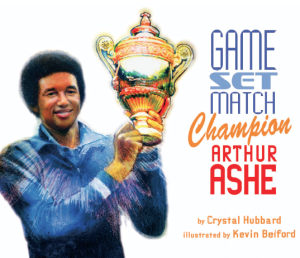
“Arthur Ashe is one of my heroes because he was a great athlete, but he was also a great human being. Tennis propelled him to fame, and he used his stature to bring attention to causes that people might otherwise have ignored. He used sports to help change the world for the better, not to get rich or gain popularity.
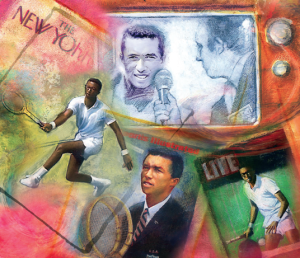
“I am most impressed by Mr. Ashe’s efforts to focus the world’s eyes on Apartheid. Through sports, he managed to bring attention to South Africa’s policy of racial segregation, and he was the first major sports figure to do so. Having grown up in segregated Richmond, Virginia, one would think that Mr. Ashe would have confronted Apartheid with anger, but he didn’t. A combination of intellect, tenacity, compassion, and fearlessness fueled his crusade. At the beginning, he was a one-man silent storm, and his approach worked. He drew others to his cause without fire and righteousness, but with reason and hope.

“Mr. Ashe is an example of how one person can truly make a difference in the lives of many. He showed me that someone from the humblest of beginnings can make a monumental change in the way we think about people who are different from us, or who need our help.”
Further reading:
Black History Month: Why Remember Robert Smalls?
Black History Month: Why Remember Toni Stone?
Black History Month Book Giveaway
Filed under:
Curriculum Corner Tagged:
African/African American Interest,
Arthur Ashe,
black history month,
discrimination,
dreams and aspirations,
overcoming obstacles,
Sports,
Tennis 


By:
Jaclyn DeForge,
on 2/11/2013
Blog:
The Open Book
(
Login to Add to MyJacketFlap)
JacketFlap tags:
Resources,
Reading Aloud,
multicultural books,
Read Alouds,
Educators,
independent reading,
reading comprehension,
common core standards,
Curriculum Corner,
guided reading,
appendix b,
common core standards appendix b,
common core standards ela appendix b,
common core standards language arts appendix b,
exemplar texts appendix B,
smiling dogs,
diversity,
Book Lists,
Add a tag
 Jaclyn DeForge, our Resident Literacy Expert, began her career teaching first and second grade in the South Bronx, and went on to become a literacy coach and earn her Masters of Science in Teaching. In her column she offers teaching and literacy tips for educators.
Jaclyn DeForge, our Resident Literacy Expert, began her career teaching first and second grade in the South Bronx, and went on to become a literacy coach and earn her Masters of Science in Teaching. In her column she offers teaching and literacy tips for educators.
Earlier this week, I had the pleasure of meeting with a literacy expert who was SUPER involved with the creation of the Common Core Standards (!!!!!), and she gave me some important feedback about the Appendix B supplement I posted last week. To refresh your memory, what we’ve done is compiled a supplement to Appendix B that includes both contemporary literature and authors/characters of color, and that also meets the criteria (complexity, quality, range) used by the authors of the Common Core. We were lucky enough to have this literacy expert take a look at our supplement, and she gave some great suggestions:
- The texts selected for Read Aloud can be outside the text complexity bands for each grade cluster.
- Texts that are Read Aloud in lower grades can be read as Independent Reading in upper grades.
We’ve incorporated these ideas into our Appendix B supplement. So, without further ado, click here for a PDF of our new and improved multicultural supplement to the Common Core’s Appendix B.
Know who else is excited about the updated Appendix B list? This guy:
Further Reading:
What’s in your classroom? Rethinking Common Core recommended texts
Why Window and Mirror Books are Important for All Readers
Filed under:
Curriculum Corner,
Resources Tagged:
appendix b,
Book Lists,
common core standards,
common core standards appendix b,
common core standards ela appendix b,
common core standards language arts appendix b,
diversity,
Educators,
exemplar texts appendix B,
guided reading,
independent reading,
multicultural books,
Read Alouds,
Reading Aloud,
reading comprehension,
smiling dogs 


By:
Amanda,
on 2/4/2013
Blog:
The Open Book
(
Login to Add to MyJacketFlap)
JacketFlap tags:
diversity,
Book Lists,
Resources,
guest blogger,
Educators,
Power of Words,
Race issues,
common core standards,
Curriculum Corner,
windows and mirrors,
Add a tag
 Guest blogger Katie Cunningham is an Assistant Professor at Manhattanville College. Her teaching and scholarship centers around children’s literature, critical literacy, and supporting teachers to make their classrooms joyful and purposeful. Katie has presented at numerous national conferences and is the editor of The Language and Literacy Spectrum, New York Reading Association’s literacy journal.
Guest blogger Katie Cunningham is an Assistant Professor at Manhattanville College. Her teaching and scholarship centers around children’s literature, critical literacy, and supporting teachers to make their classrooms joyful and purposeful. Katie has presented at numerous national conferences and is the editor of The Language and Literacy Spectrum, New York Reading Association’s literacy journal.
When we lived in Brooklyn, I knew my sons were growing up in a diverse community. They understood that people have different skin colors. That people speak different languages. That people eat different foods. That people believe different things. That we all share a common humanity. That life is full of complexity.
Now we live in the woods and appreciate the quiet of country living but this is far from a diverse community. For my boys, there is greater diversity in the pages of a book than on the streets of their town. Multicultural children’s literature is a doorway into greater understanding that their cultural background is not the only cultural background. That their way of speaking is not the only way of speaking. That their point of view is not shared by everyone.
When we open a book and start to read a story, we use our imaginations to walk through whatever world the author has created. Children’s literature is full of stories about boys and girls that look like my children. Rudine Sims Bishop uses the terms mirror books and window books to describe how we both see ourselves and see others when we read literature. The characters my sons encounter are often mirrors and they find their life experiences reflected in the books they read. Children from dominant social groups have always found their mirrors in books, but do they have enough access to high-quality stories that represent other cultural backgrounds in a positive way?

artwork by Chris Soentpiet from Amazing Faces
My sons need more than mirror books. As I scan our reading shelves at home I know we can do better. When I walk into many classrooms, I know they too can do better. My sons and all children need books that provide windows into other life experiences to understand the diverse world we live in and to build connections to all other humans. After all, when the lighting is just right can’t a window become a mirror?
My friend, colleague, and global literacy leader Pam Allyn takes Charlotte’s Web with her when she travels to Lit Clubs in Kenya, Haiti, and South Korea. She takes Charlotte’s Web because even though the children she meets do not look like or speak like Fern, there is a shared humanity in E. B. White’s words that is unparalleled, and all children can find a mirror in Fern’s courageous spirit. Pam has created Lit Clubs and Lit Camps through her organization LitWorld that emphasize the human strengths found in stories. Imagine if all the stories we read with children were framed around human strengths? What strengths would you choose?
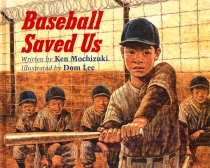
Of course, stories also help us understand that the world we live in is not what it should be. Stories can help young children understand that racism very much exists in this country, and that power is unequally distributed based on race, class, and gender. For children from dominant groups, window moments in stories come when the children realize they hold a powerful place in society and that there is something unjust about this. Two stories that center on human strength and offer powerful mirror/window possibilities for children are Baseball Saved Us by Ken Mochizuki and Seeds of Change: Planting a Path to Peace by Jen Cullerton Johnson. Baseball Saved Us is about an underdog believing in himself and the strength that comes from confidence, but it also tells about an ugly chapter in United States history when Japanese Americans were sent to internment camps during World War II. Seeds of Change is a story of perseverance in the face of political opposition and bias against women. It is also about respecting nature and the power of collective action to change a landscape and the sustainability of a nation. There are many more such stories. Yet, are we reading them to children at home and in our classrooms?
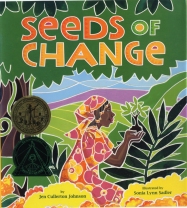
President Obama in his Second Inaugural Address emphasized the legacy of Dr. Martin Luther King Jr. when he said, “our individual freedom is inextricably bound to the freedom of every soul on Earth.” Stories can help children realize this. Isn’t a sense of social justice something we want all children to develop? Through the thoughtful selection of books we read to our children we take a step toward creating adults who desire a world that is better than the one we live in today.
So, parents and teachers, what can you do?
- Acknowledge that every story has mirror and window possibilities
- Emphasize that we live in a diverse society
- Arm students with stories where their background is represented in a positive light and where their life experiences are validated
- Discuss themes in stories to unpack mirror possibilities for all children
- Read aloud stories that represent positive aspects of the human spirit and where characters rally together for collective action
- Be open to discussions of inequality that you see in stories and in life; discuss with children a vision for a better world
- Look for links to literacy standards such as the Common Core State Standards Reading Literature Standard 6 across grade levels; this is a strand of standards that emphasizes point of view
Further reading:
What’s in your classroom library? Rethinking Common Core recommended texts
A More Diverse Appendix B
Filed under:
Book Lists,
Curriculum Corner,
guest blogger,
Resources Tagged:
common core standards,
diversity,
Educators,
Power of Words,
Race issues,
windows and mirrors 

View Next 16 Posts
 Jill Eisenberg, our Resident Literacy Expert, began her career teaching English as a Foreign Language to second through sixth graders in Yilan, Taiwan as a Fulbright Fellow. She went on to become a literacy teacher for third grade in San Jose, CA as a Teach for America corps member. She is certified in Project Glad instruction to promote English language acquisition and academic achievement. In her column she offers teaching and literacy tips for educators.
Jill Eisenberg, our Resident Literacy Expert, began her career teaching English as a Foreign Language to second through sixth graders in Yilan, Taiwan as a Fulbright Fellow. She went on to become a literacy teacher for third grade in San Jose, CA as a Teach for America corps member. She is certified in Project Glad instruction to promote English language acquisition and academic achievement. In her column she offers teaching and literacy tips for educators. 

































 With all this reading in overdrive, it is understandable that few students (and teachers) want to keep reading at home for pleasure. Yet we need to sustain student excitement for reading and prevent testing anxiety. Now more than ever, students need the bigger picture of how literacy helps us as citizens, the experiences of deriving joy from print, and practice using books for stress management.
With all this reading in overdrive, it is understandable that few students (and teachers) want to keep reading at home for pleasure. Yet we need to sustain student excitement for reading and prevent testing anxiety. Now more than ever, students need the bigger picture of how literacy helps us as citizens, the experiences of deriving joy from print, and practice using books for stress management.


































I have been reading to my daughter in Spanish since she was a baby (she is now four) but she occasionally rebels. Thanks for these great tips!
Reblogged this on adventureswiththepooh and commented:
If you want to read to your child in Spanish, check out these great tips!